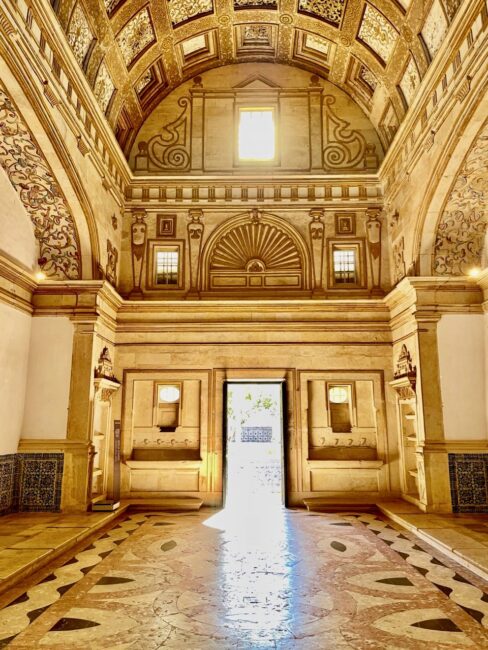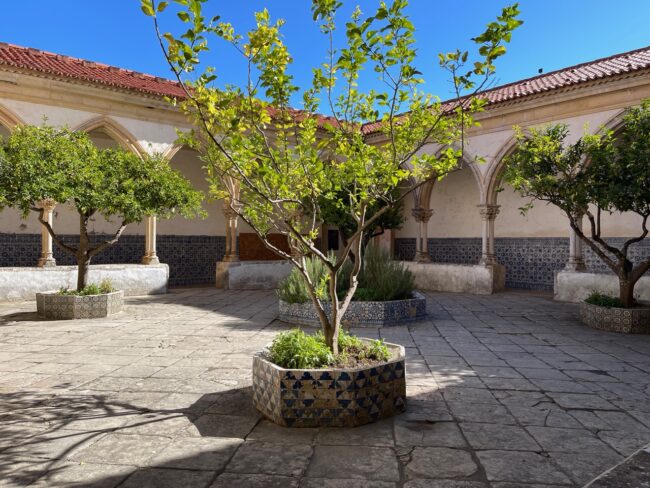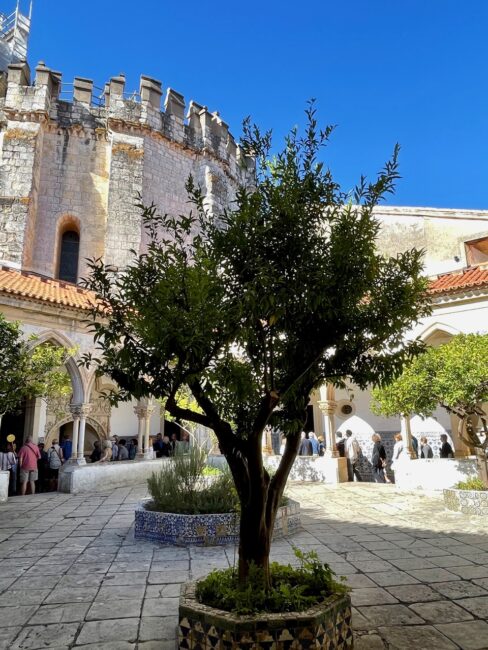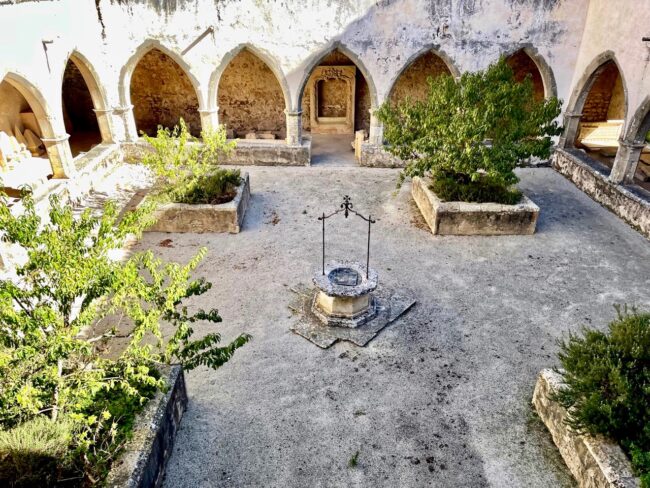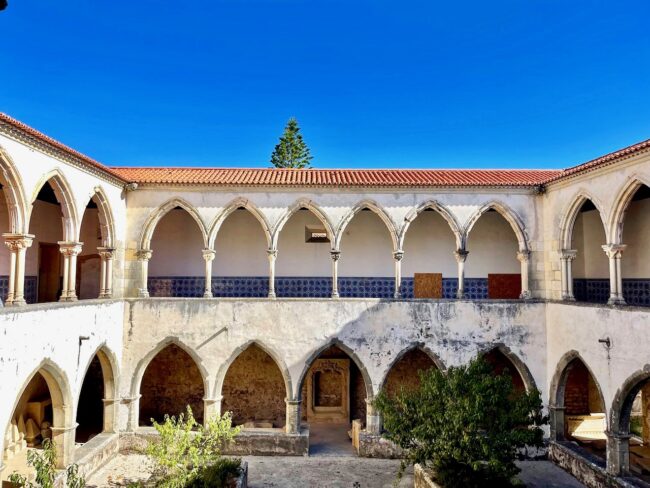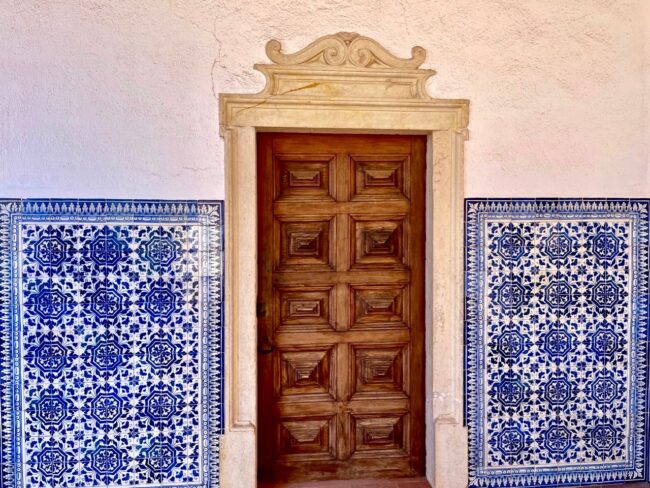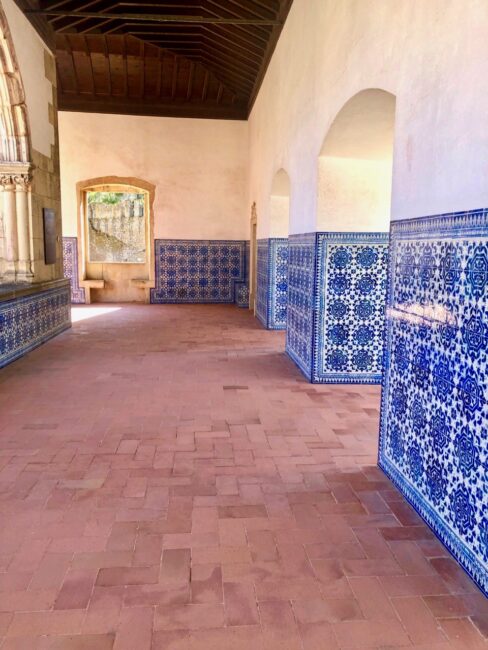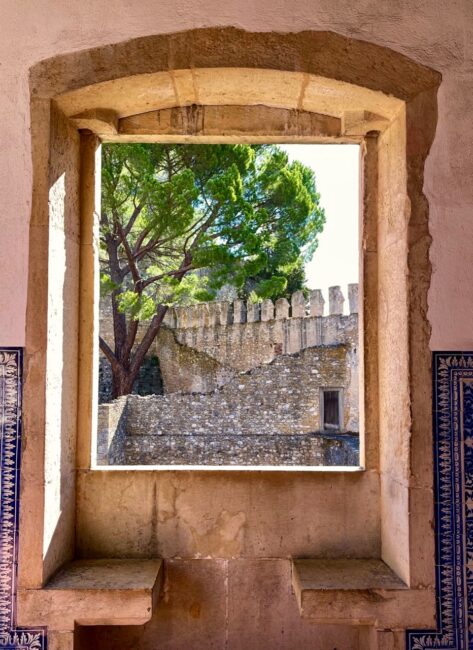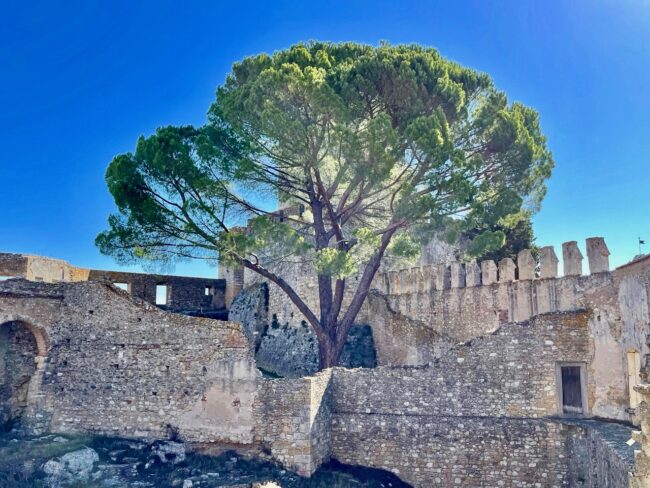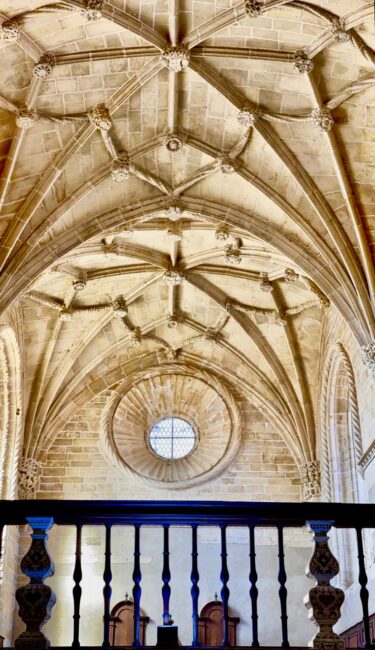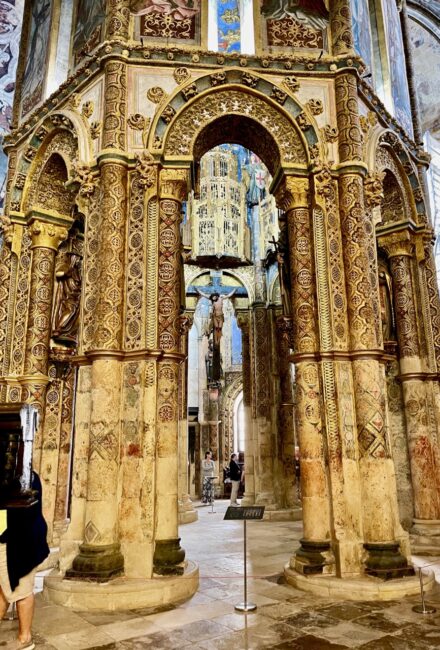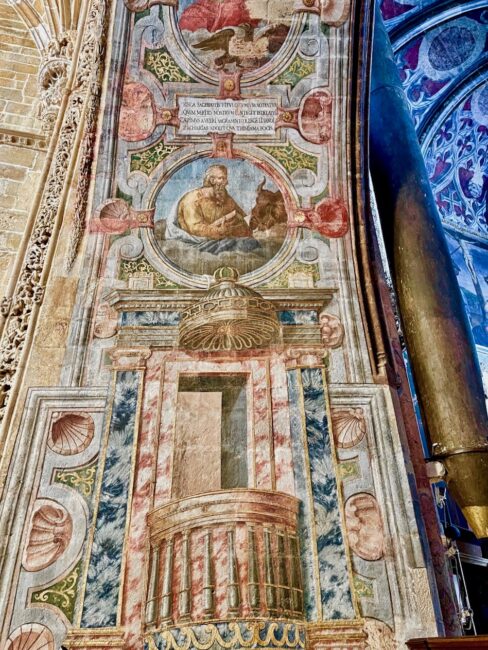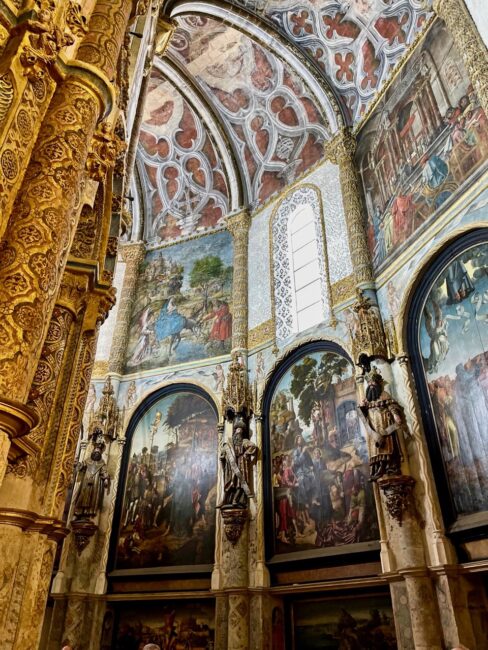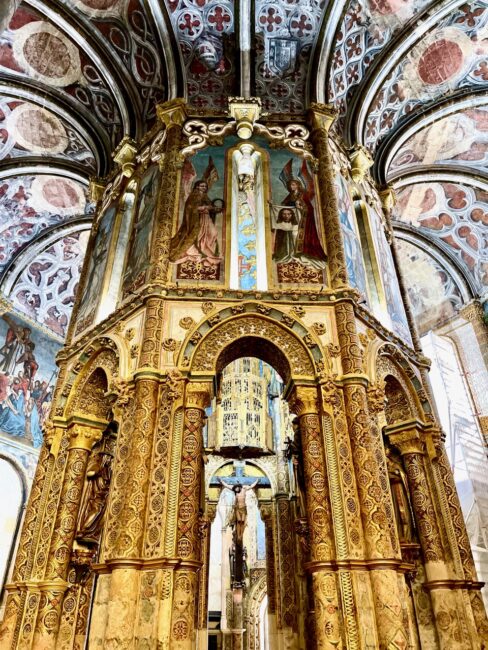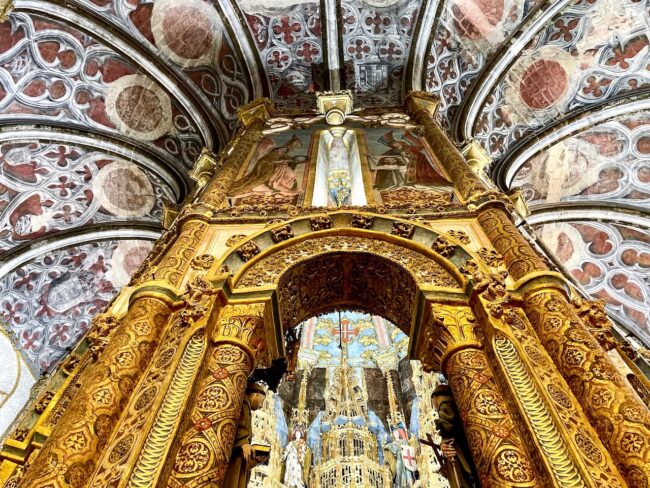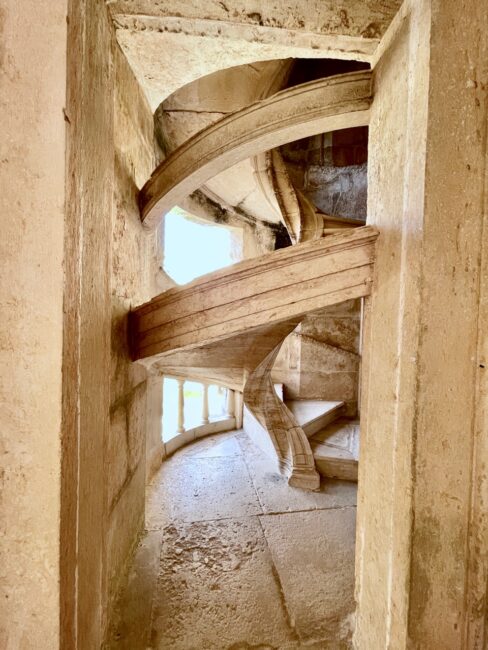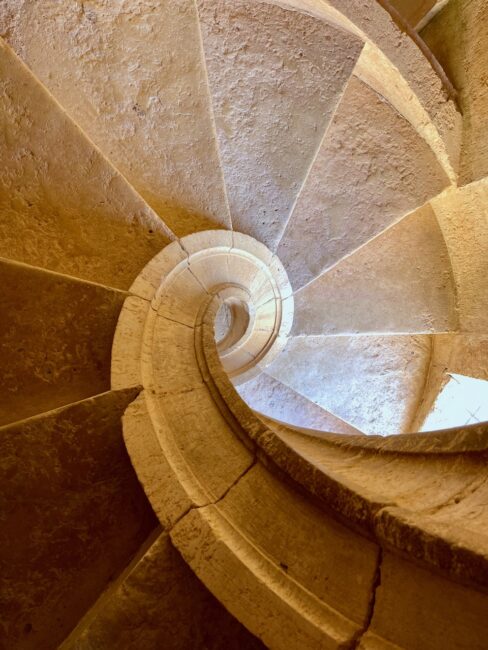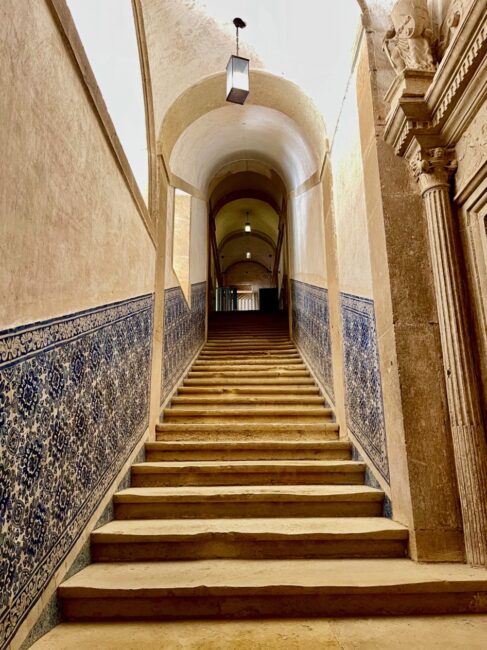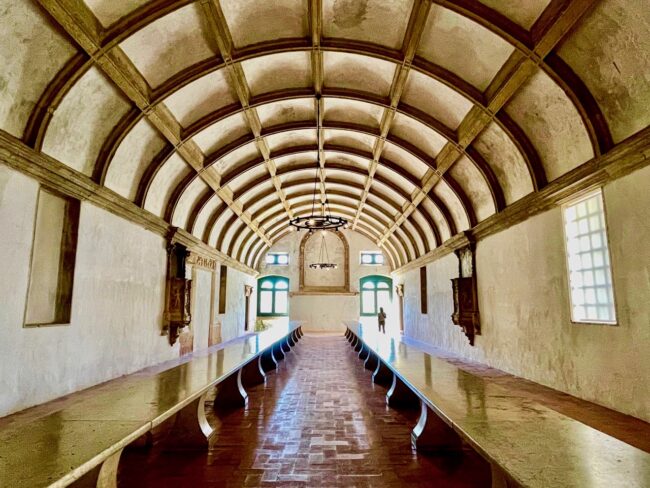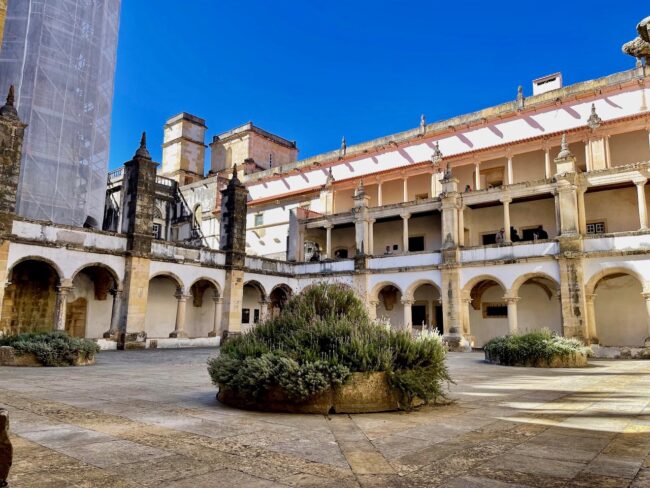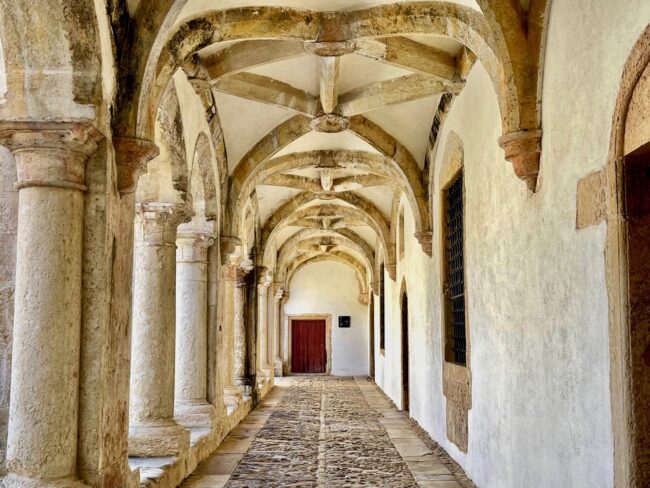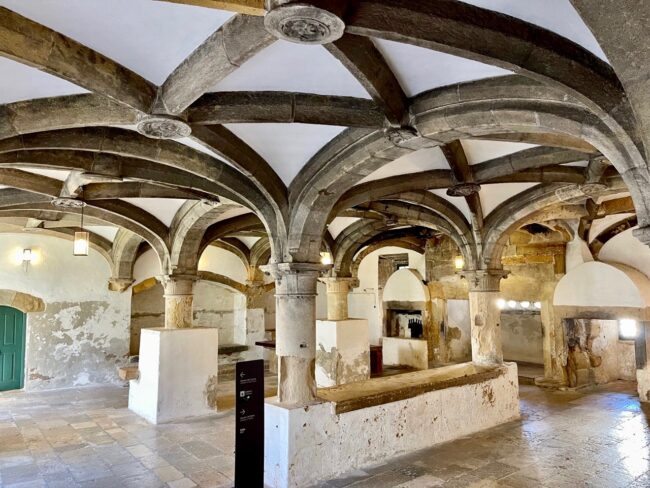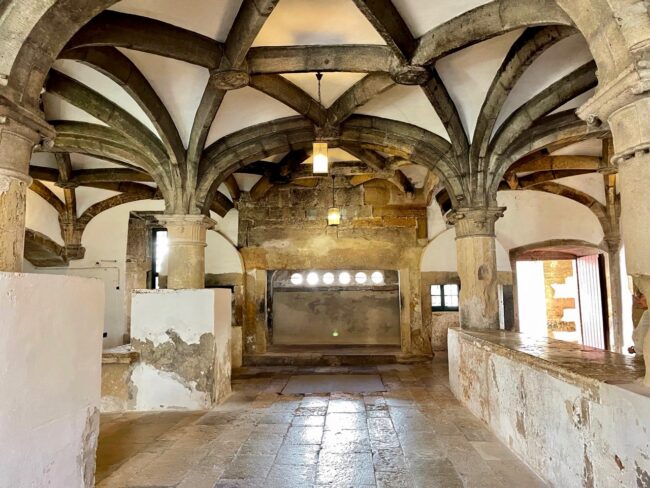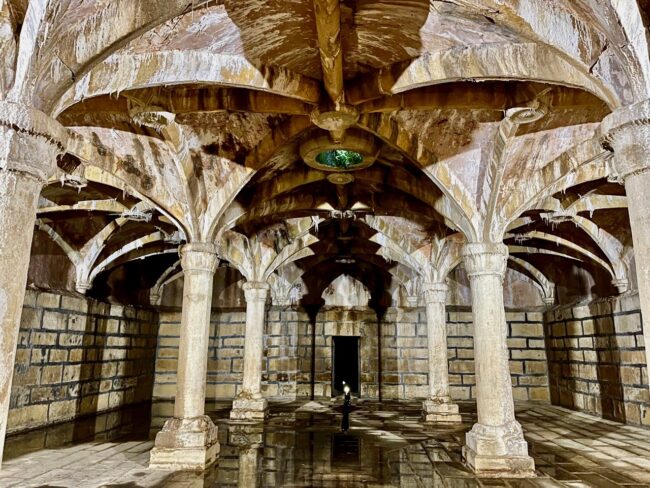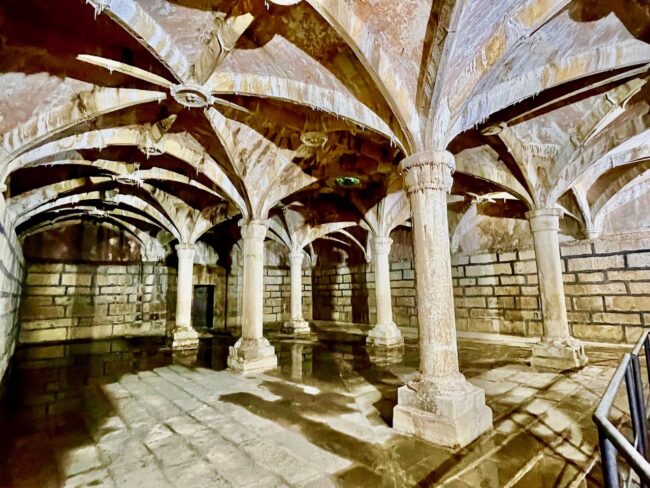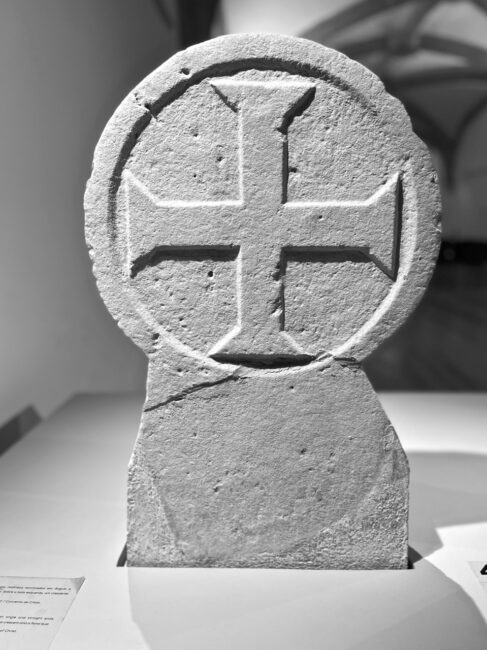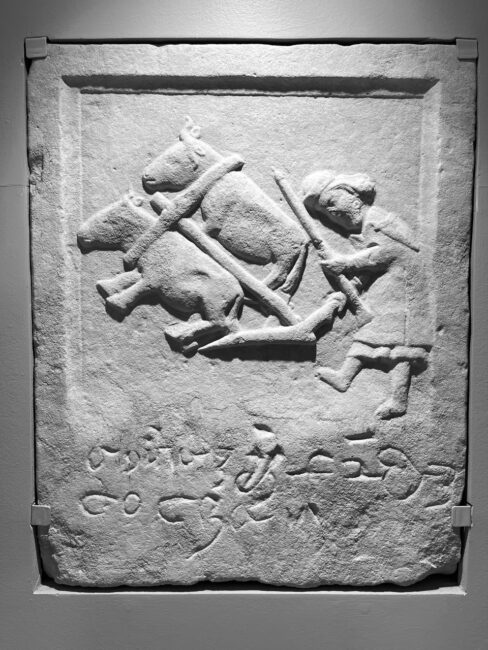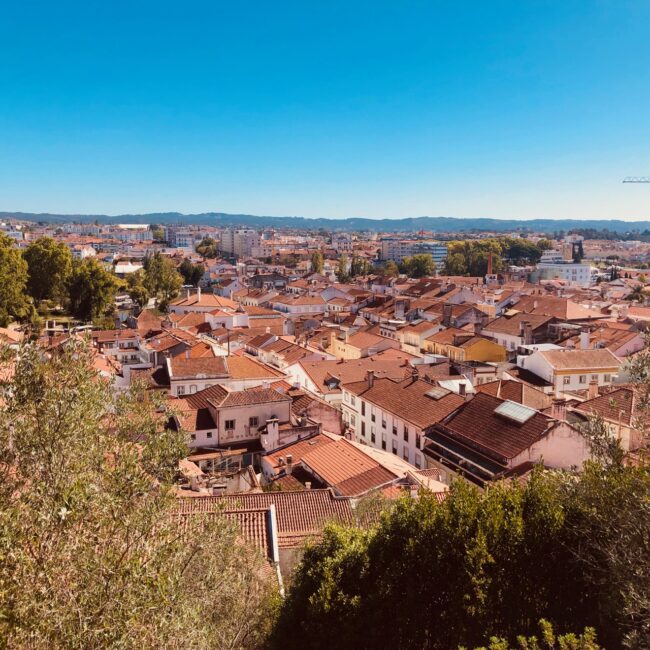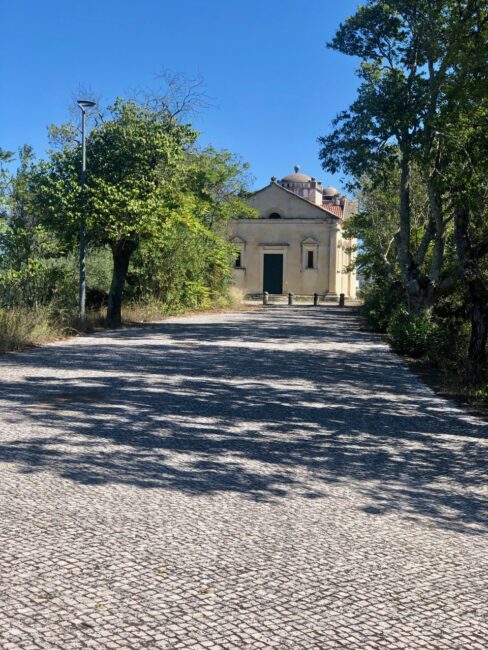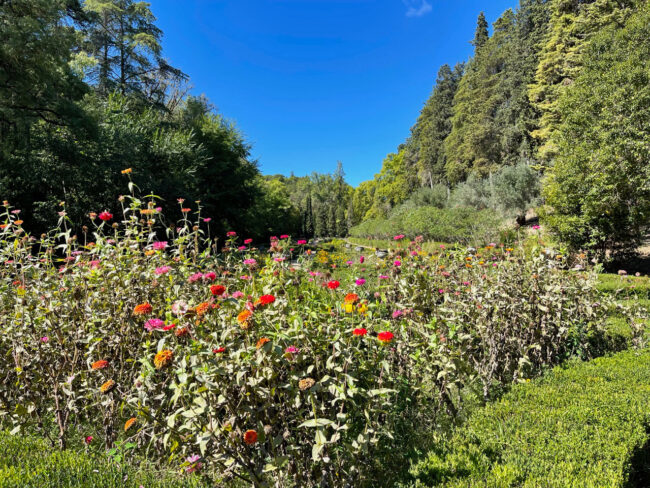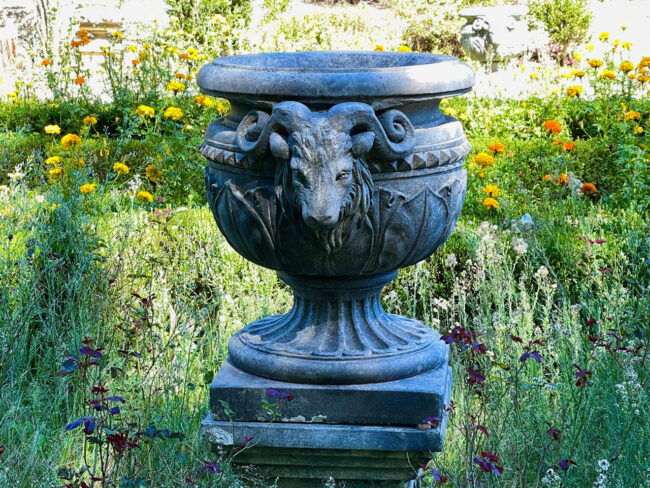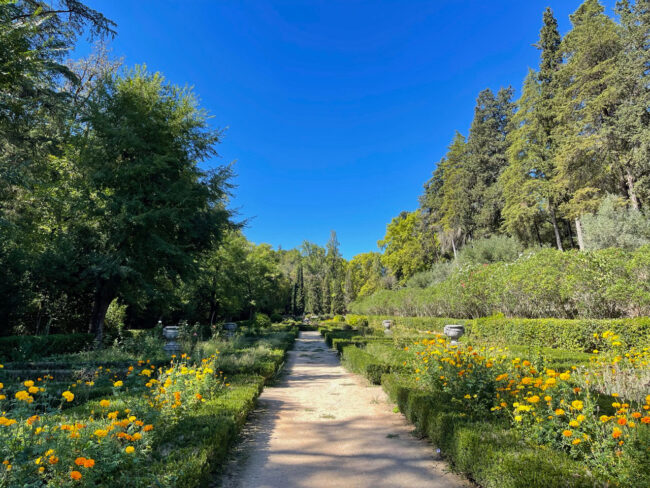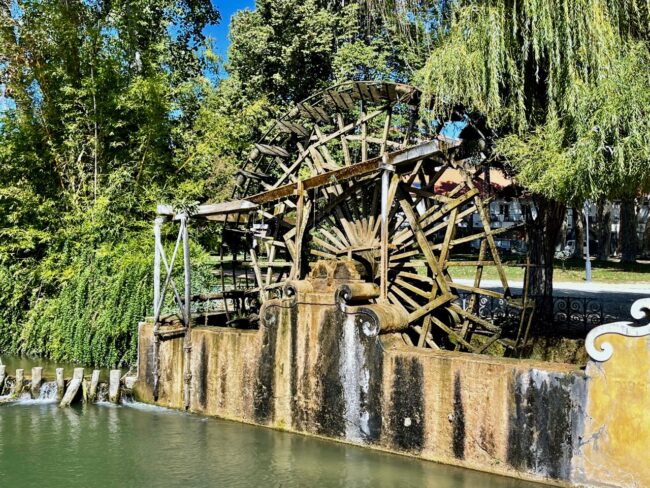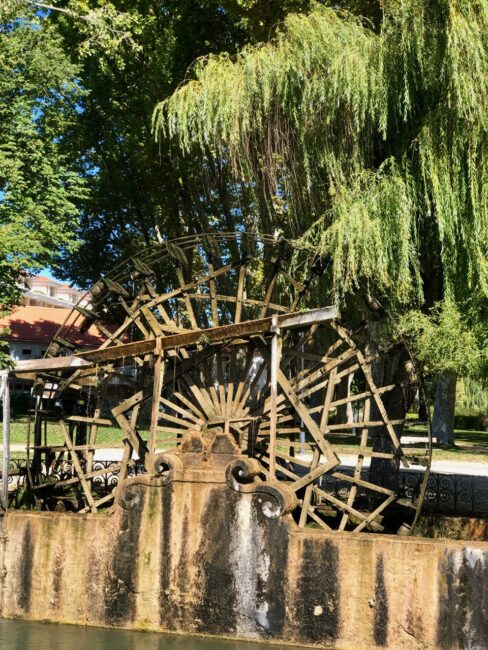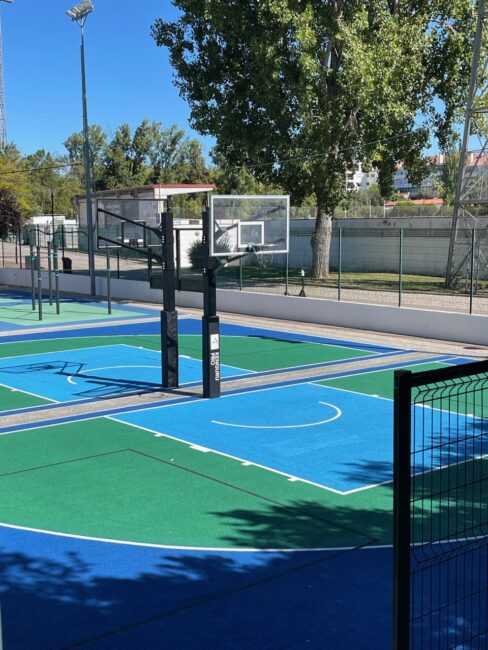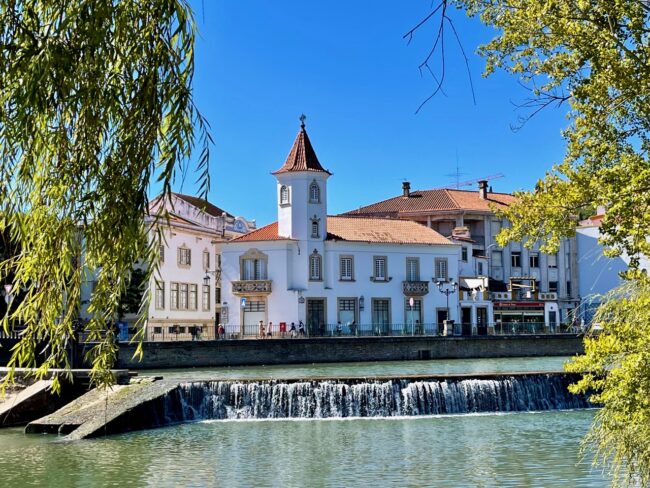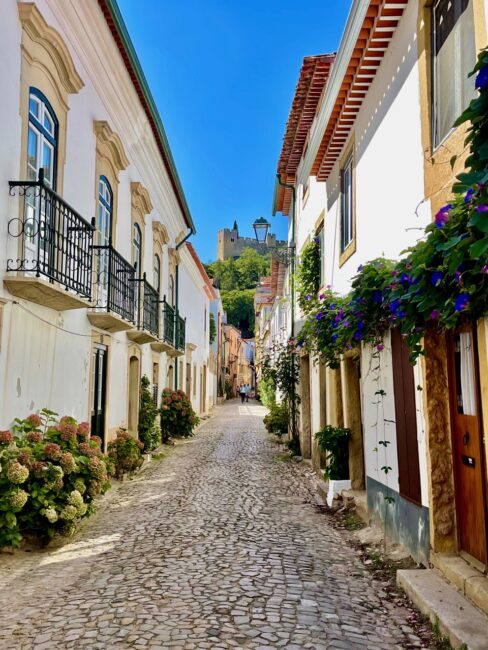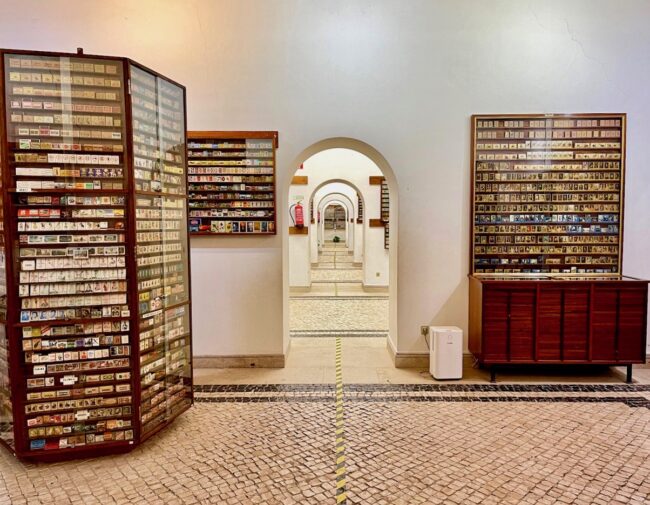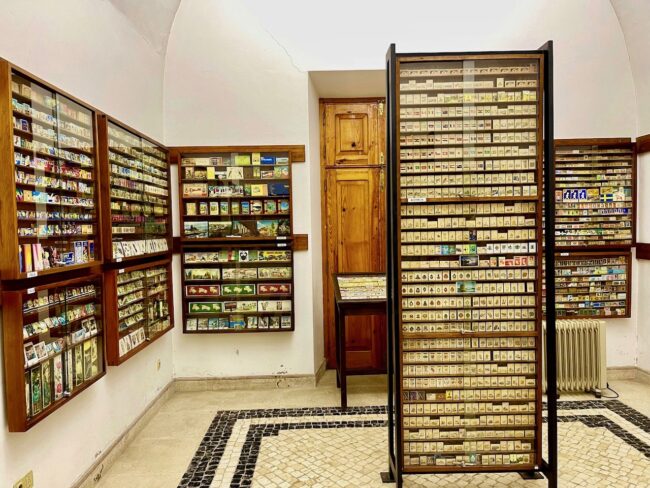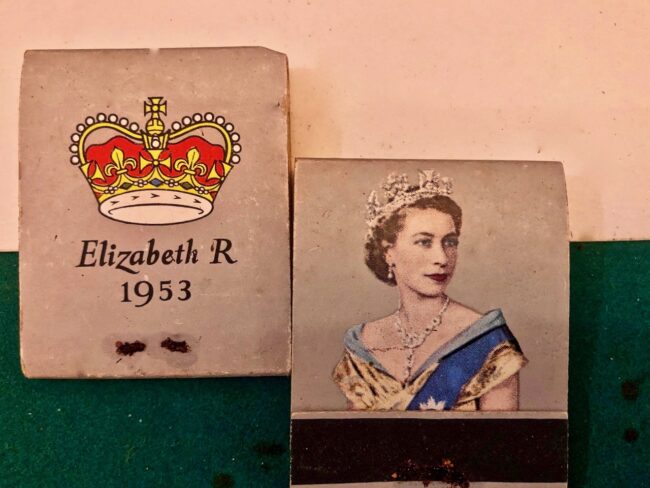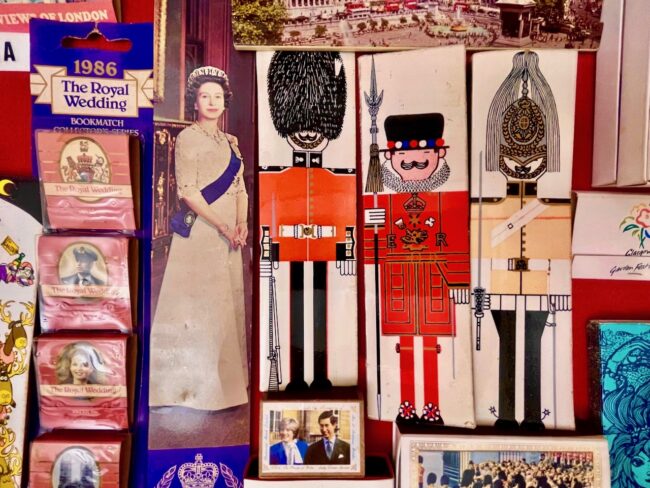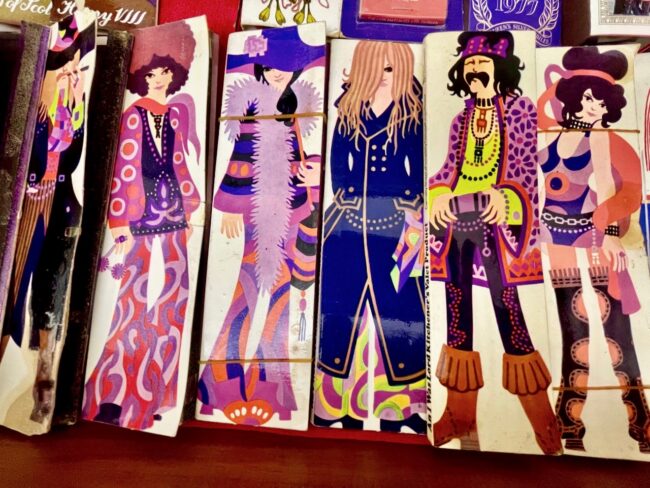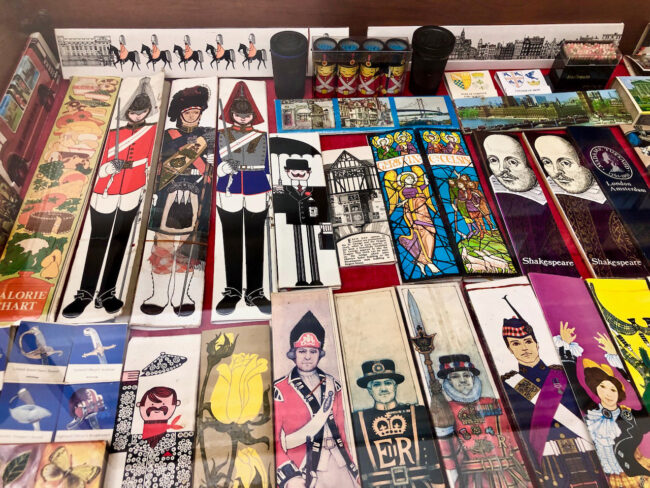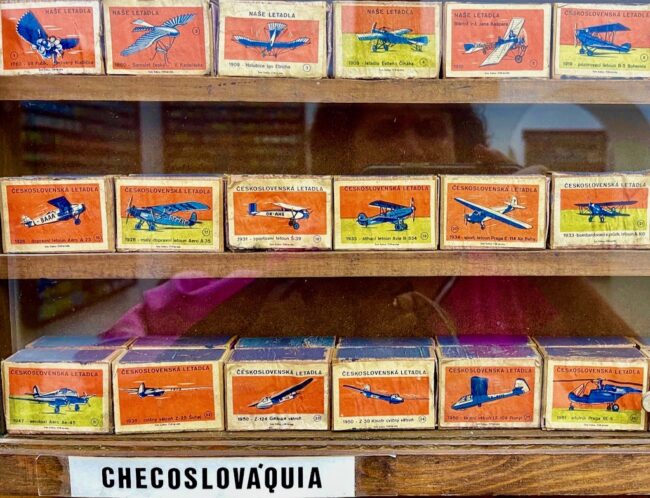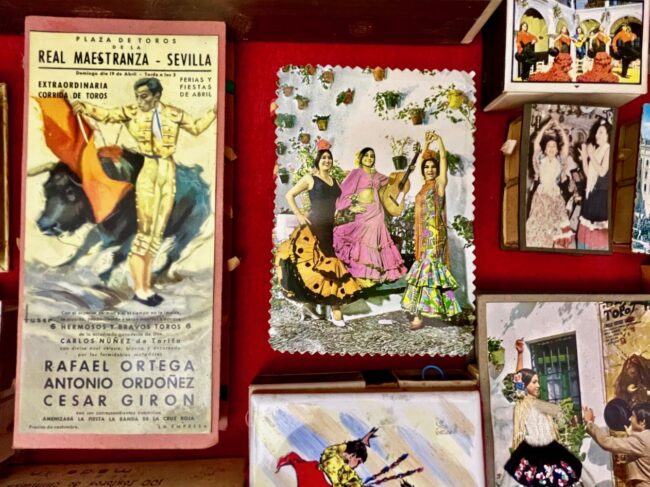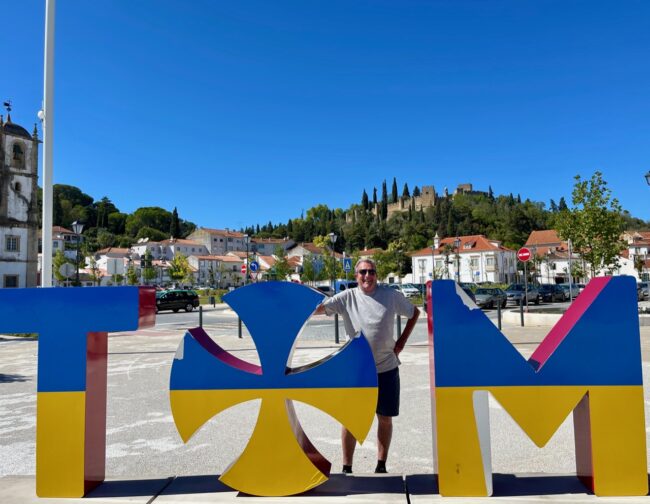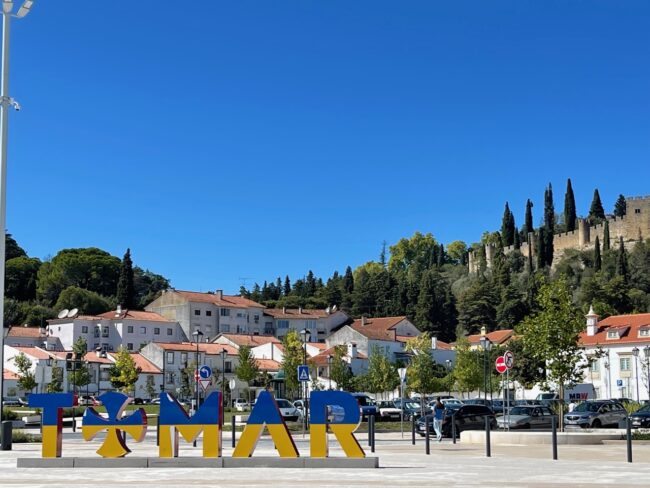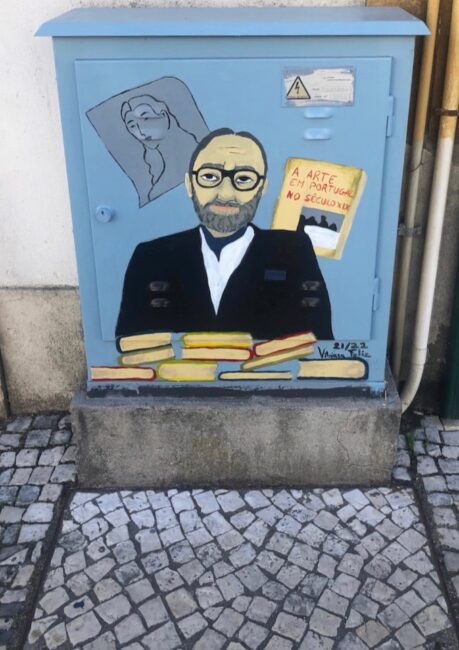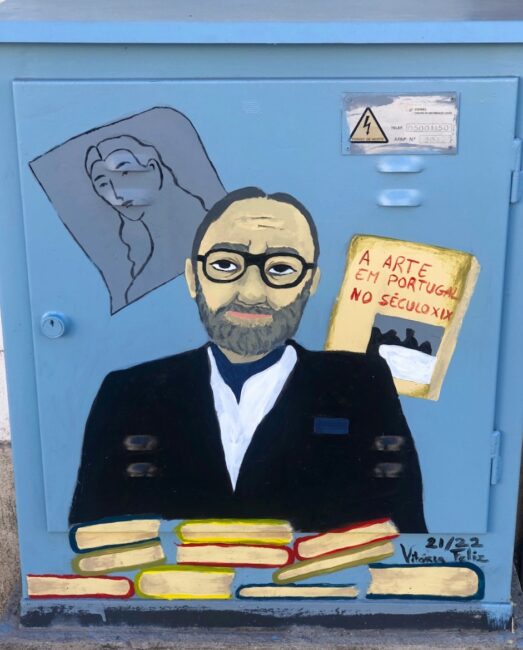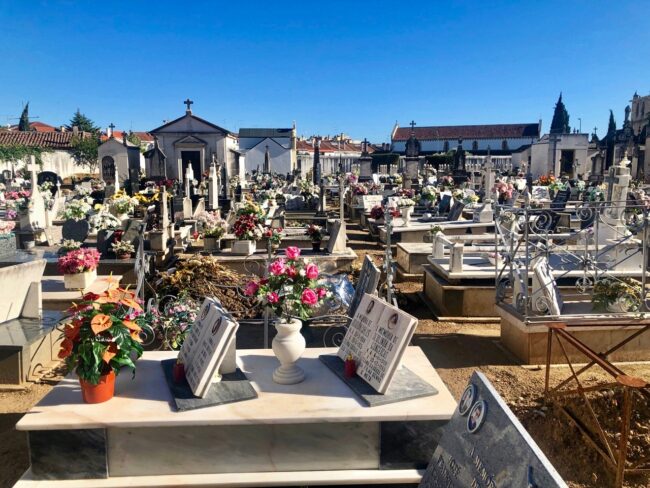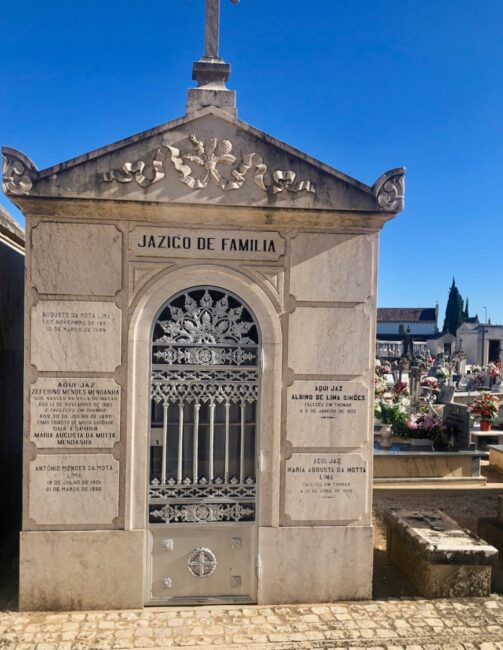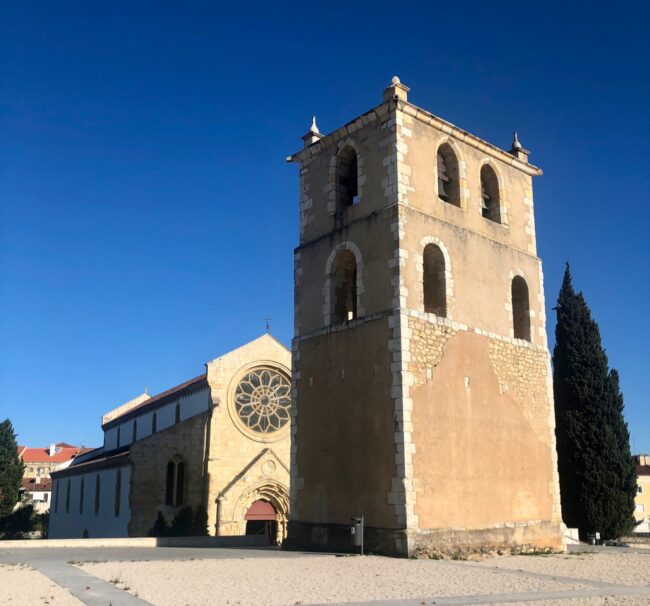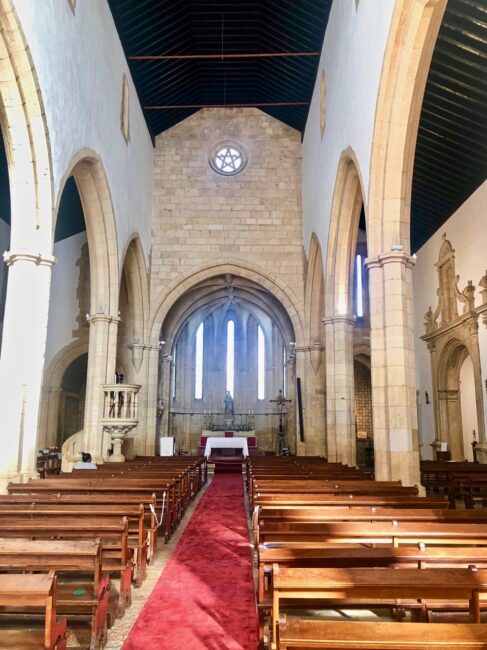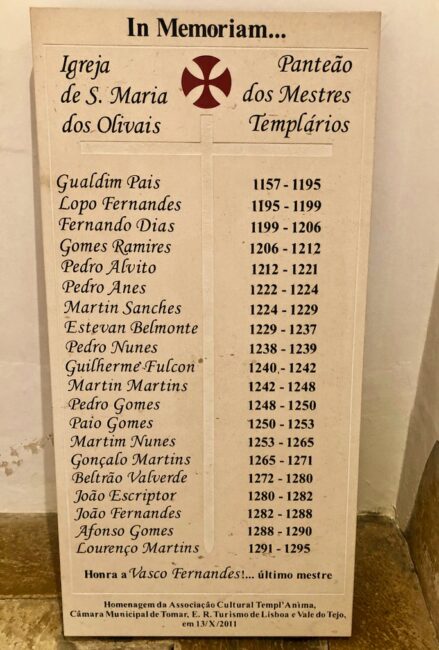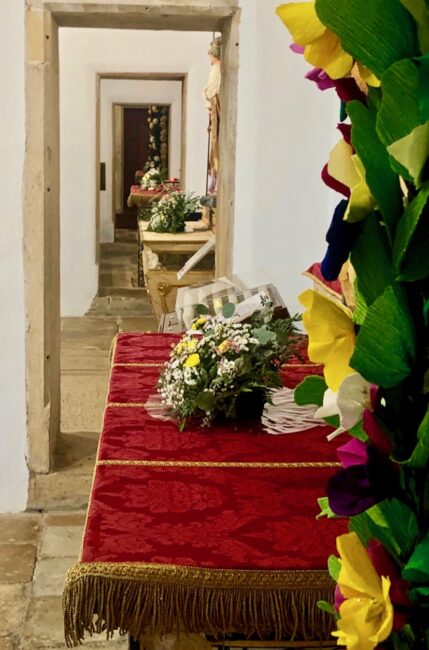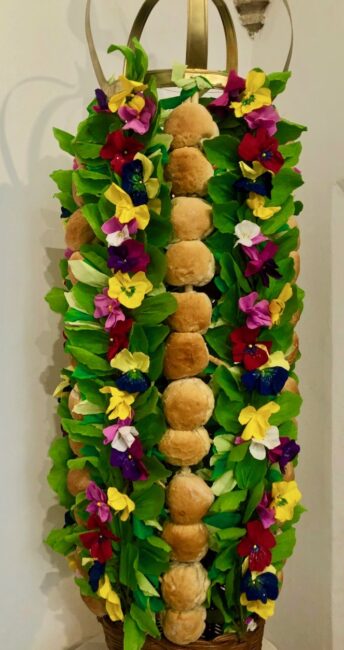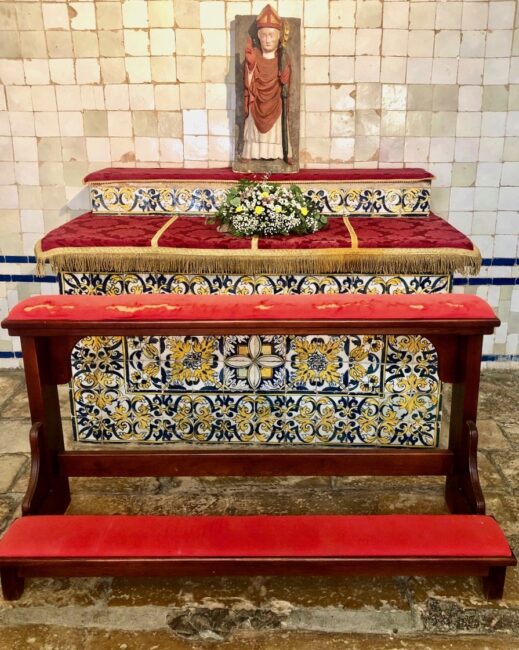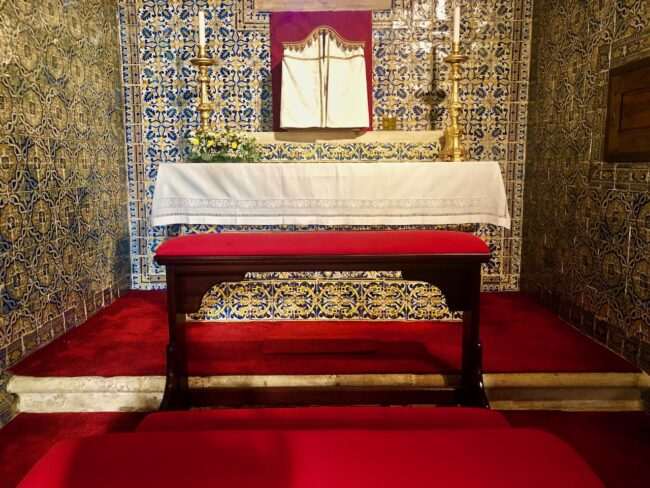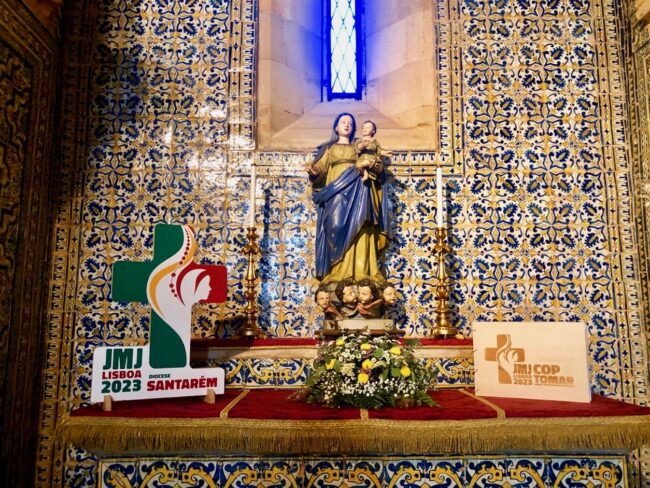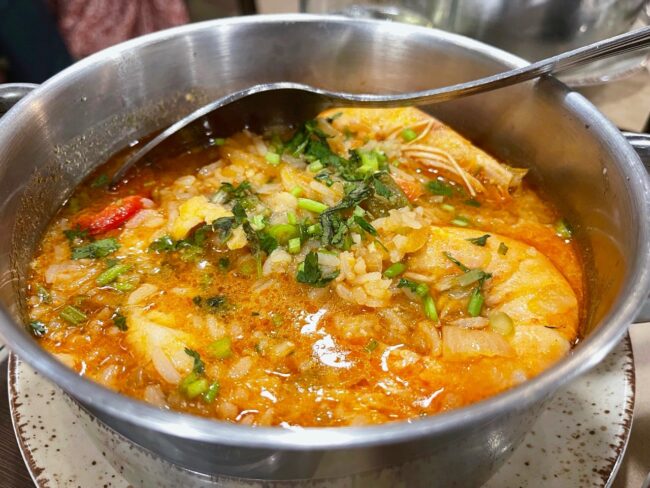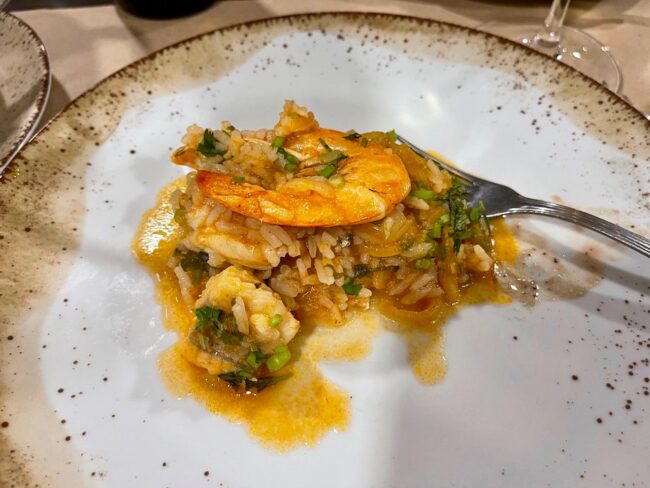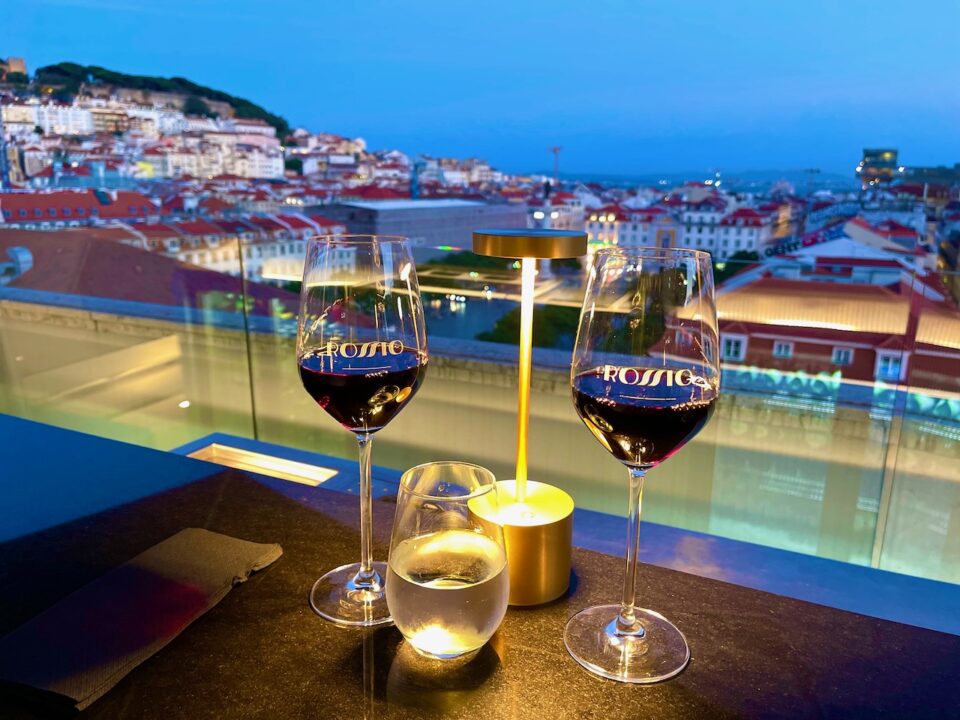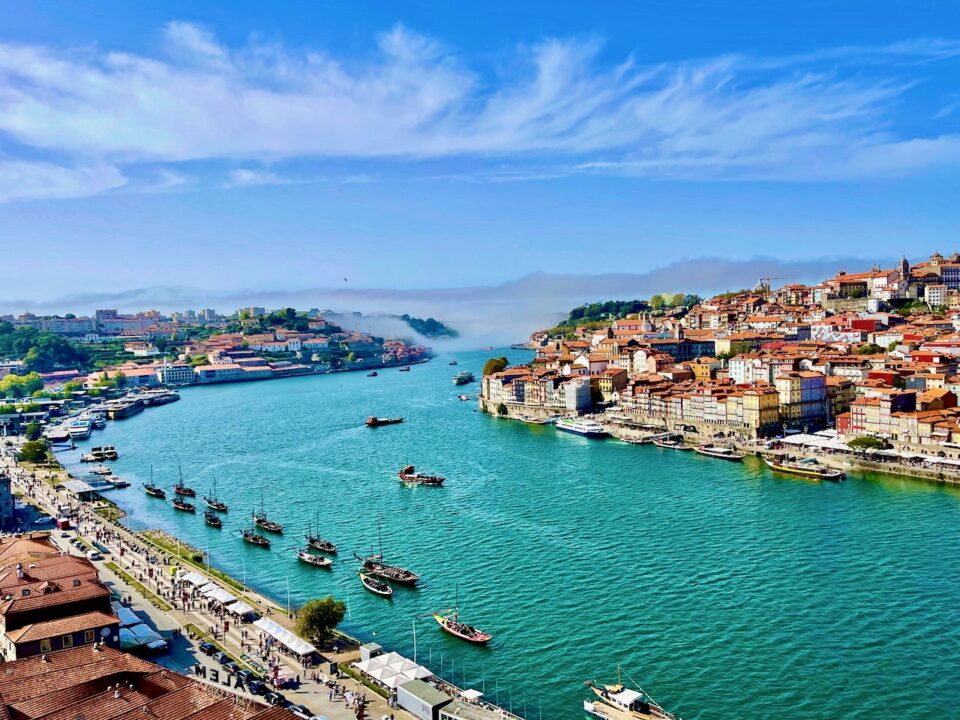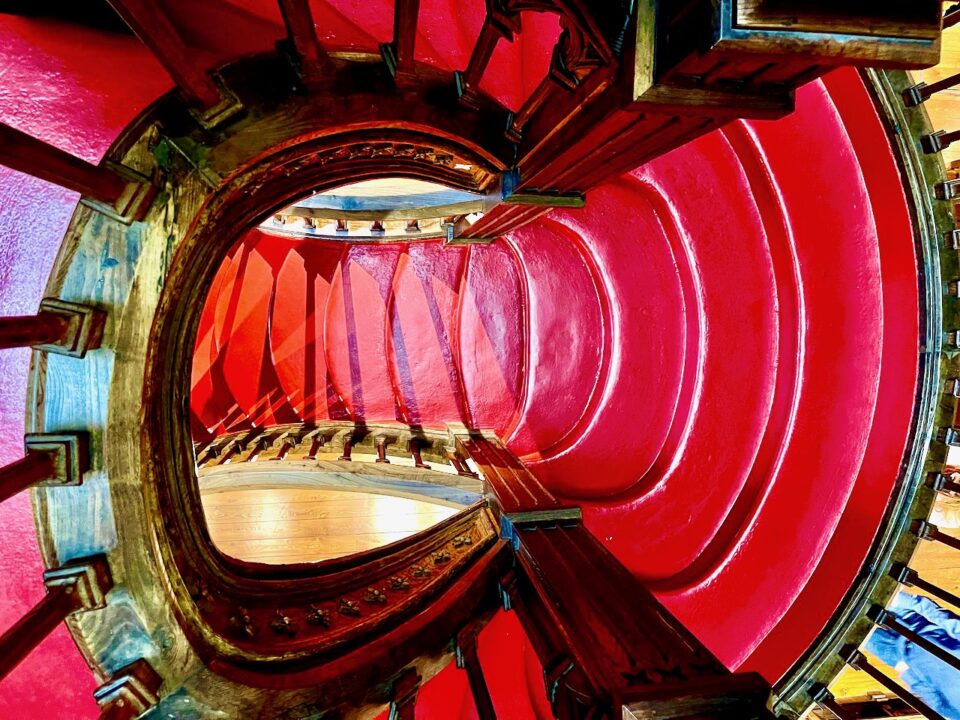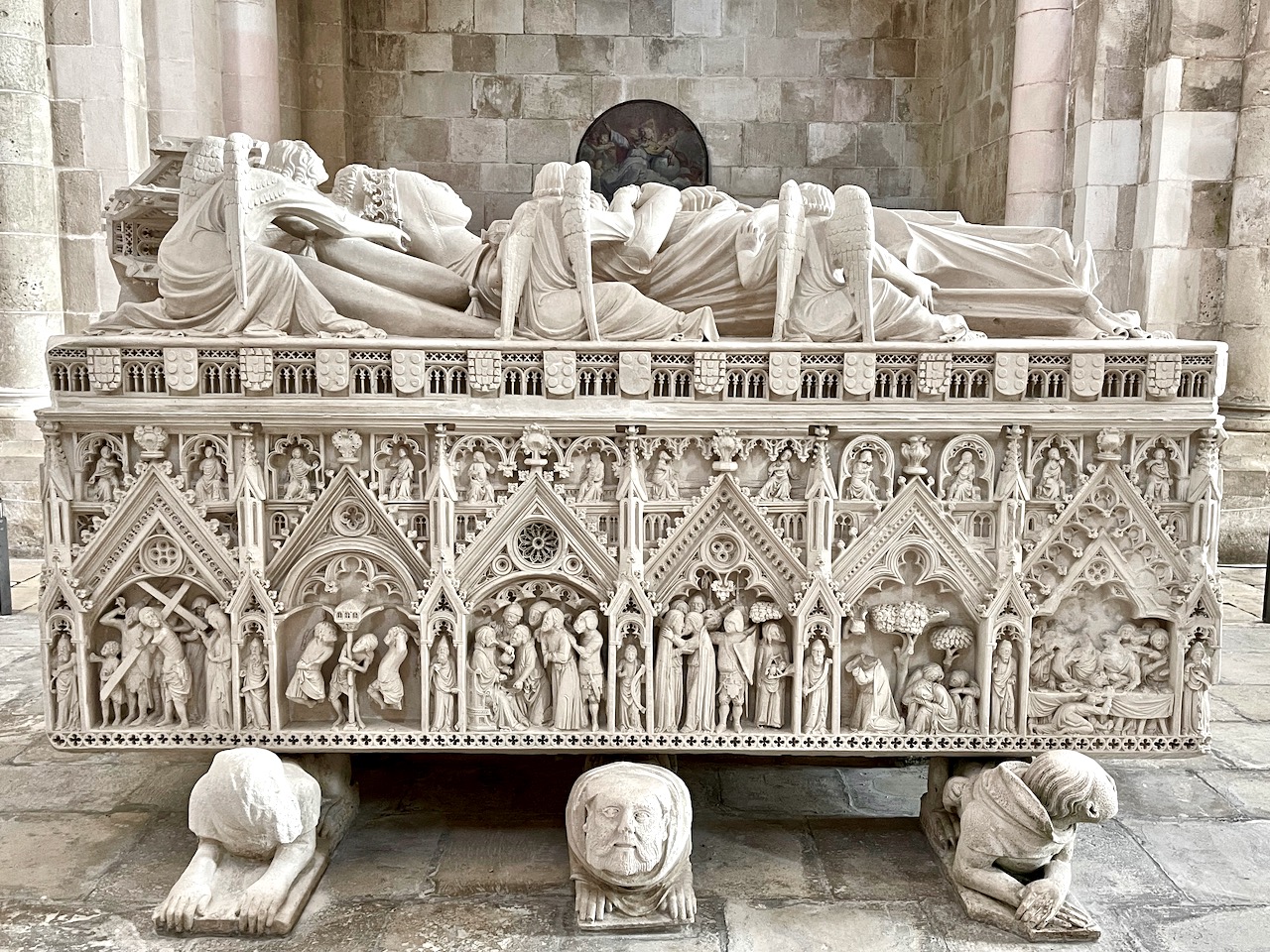
Chapter Ten – Two UNESCO World Heritage Sites On The Way To Tomar
January 19, 2023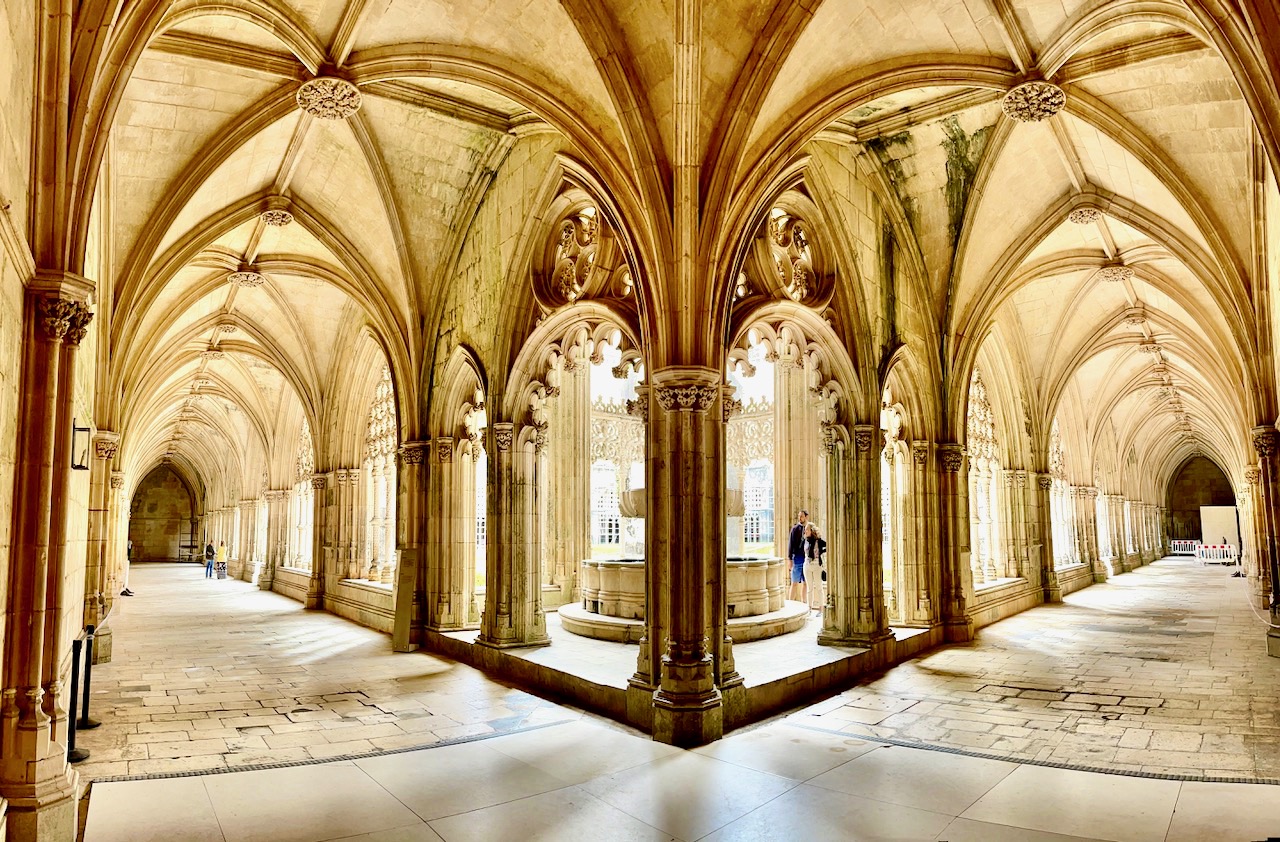
Chapter Twelve: Tomar To Coimbra
February 4, 2023Falling For Portugal: A Mai Tai Tom “Trip” Report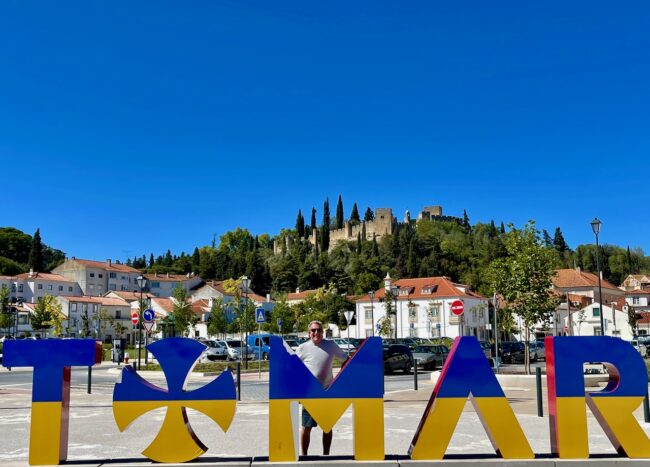
Chapter Eleven: Traversing Templar Tomar
Day Eleven: Hanging With The Templars, Barely Beating The Crowd, Window of Opportunity Shut, Traversing Tomar, Forest Tuckered, Weeping Water Wheel, The Match Game, Danger Of Death, Checking Out Tomar’s Heritage, My New Almost Girlfriend and Bohemian Rhapsody
Time to explore a little of historic Tomar. Near our hotel, we ventured across the bridge with three names … Old Bridge, Ponte Velha or Dom Manuel Bridge, which may or may not have been built over an old Roman Bridge, crosses the Rio Nabão. That was a lot of information to digest after only one cup of coffee. In any event, our destination was that big fortress on top of the hill in the distance, the Convento de Cristo.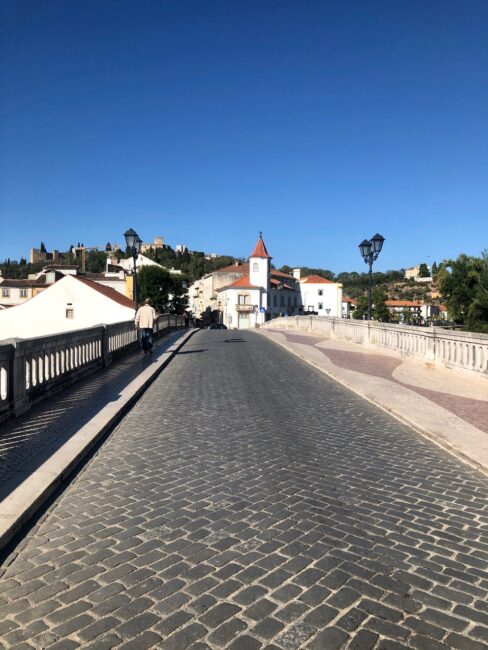
Once again, the sky was that deeper shade of blue that almost looks fake.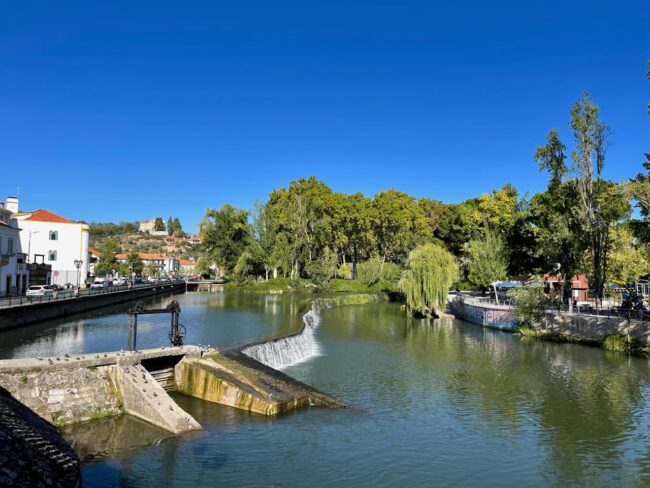
Our goal along the way to the castle was to visit the late 15th-century Igreja de São João Baptista. We reached the Praça da República where the church commemorated by Henry The Navigator is located, and much to our disappointment the church was closed for renovation with scaffolding covering its exterior. Instead, we took a picture of the square with the statue of the founder of Tomar (Guildim Pais) standing tall in the center. Only a few of the Tomar pigeons greeted us.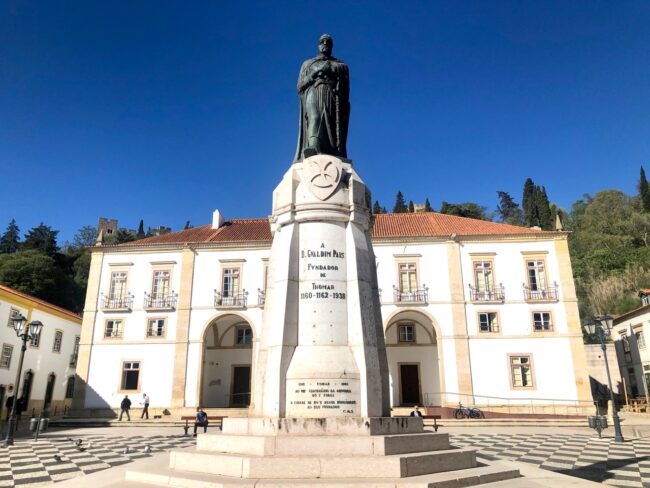
Continuing our walk through town …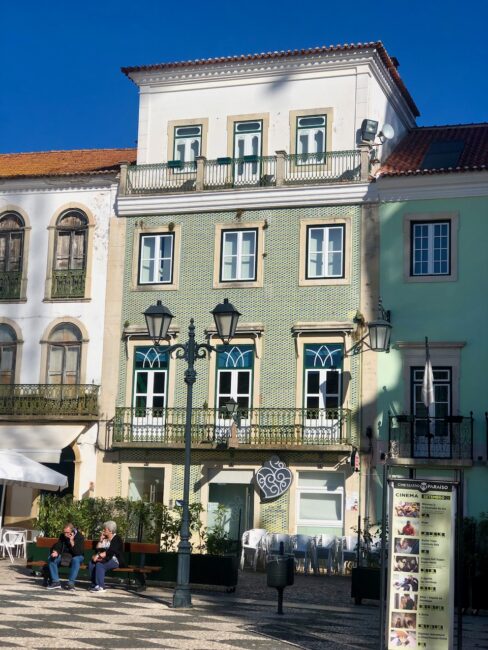
… we reached the hill that provided views over Tomar. All that walking in Lisbon and Sintra had paid off, as the walk up was of no difficulty.
Besides being a UNESCO World Heritage site, Convento de Cristo was also the second of the places we’d see on the World Heritage Route (Mosteiro de Alcobaça and Mosteiro da Batalha being the others). The combo ticket we had purchased the previous day at Alcobaça gained us entry. First we explored the New Sacristy. Although Convento de Cristo was founded in the 12th century by the Grand Master of the Templar, this was part of the 16th-century rebuild when the second church was consecrated.
We have no idea where this ceiling photo was taken, but it was right after we entered and it was either in or near the New Sacristy, although it seems more rustic. Oh well, nice shot nonetheless.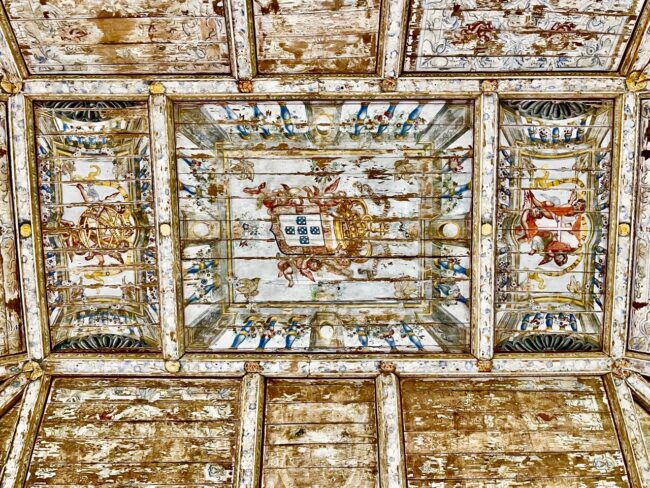
Since we had gotten a late start on the morning, we barely beat the tour busses and in order to dodge the gathering hordes, we did not visit the Convento in the order we should have. There were lots of cloisters, so I hope I don’t get them too confused. I think this one is the Cemetery Cloister where friar knights and others in the convent were buried. We were deftly attempting to stay one step ahead of the crowd, but they seemed to be gaining on us.
The Claustro de Lavagem (Wash Cloister) is the two-story cloister where the monks washed their clothes. Unfortunately, I left all my quarters in the states.
By now, I was completely enamored of those beautiful blue azuelos, and plenty could be found here on the second floor, including this colorful corridor. It was constructed at the time when Prince Henry the Navigator was Grand Master of the order in the 15th century.
From here we took a look at the entrance staircase.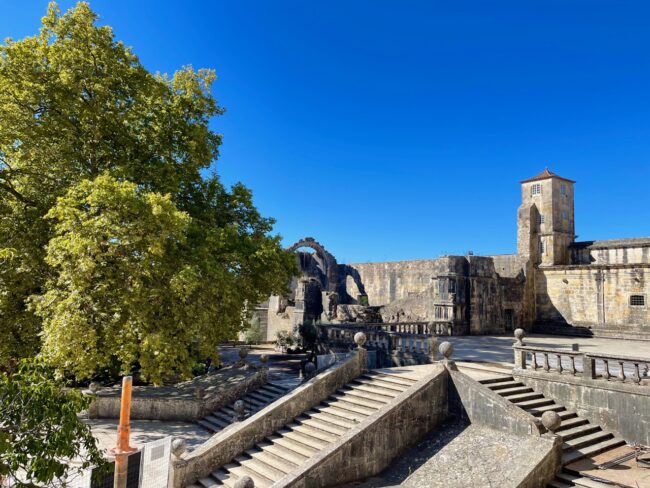
We could also look out onto the castle ruins from what I believe were Prince Henry’s Quarters. I knew someone had quarters.
Near the Claustro de Lavagem we were about to enter …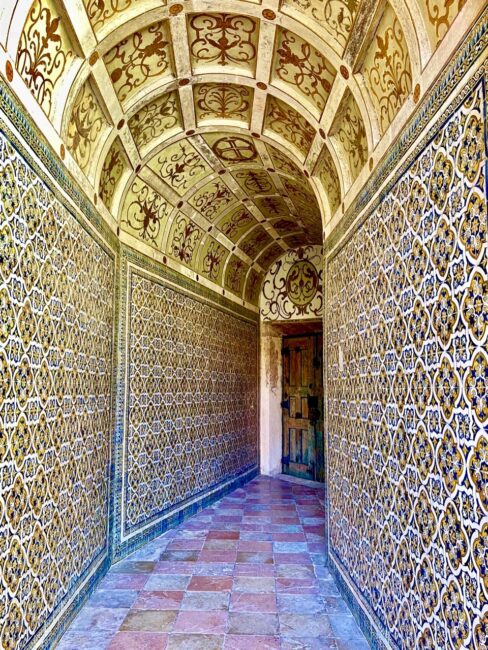
… the Portocarreiros Chapel named after António Portocarreiro along with his wife and kids that was constructed in the 1620s. Can’t get enough of these tiles.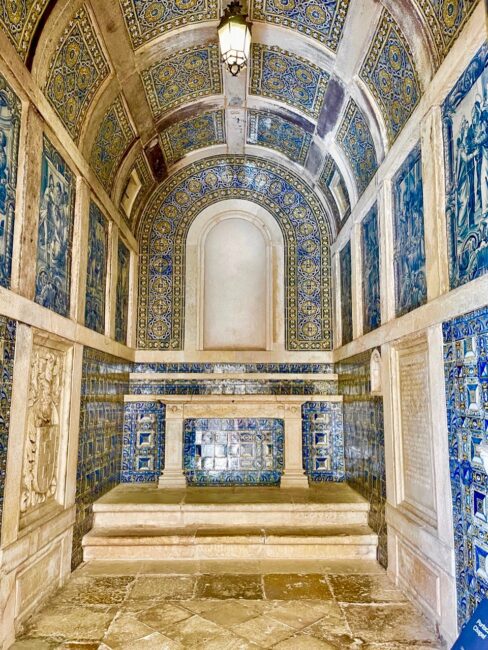
Now it was time to enter the Round Church (Tomar Charola or Rotunda).
This stunning part of the convent dates all the way back to the 12th century when this was a Romanesque fortified oratory that was inspired by the Church of the Holy Sepulchre in Jerusalem.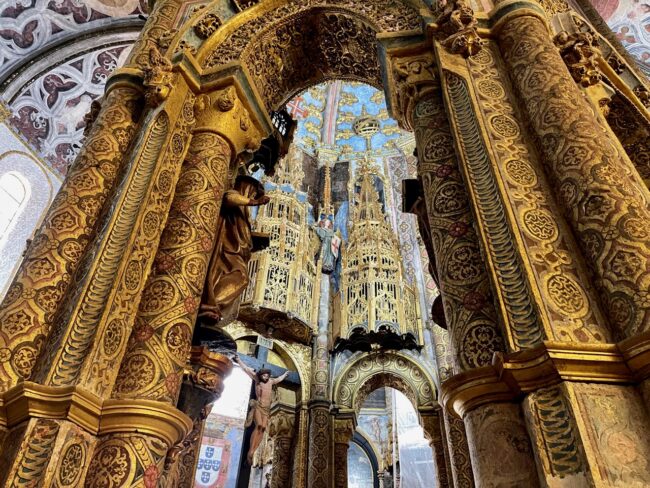
King Manuel commissioned the paintings, wooden statues and gold trimmings.
The 16-sided octagonal Charola is definitely the most photographic spot in the complex. It reminded me of the Mezquita in Cordoba, Spain, and other Spanish buildings we saw when there that meshed Moorish-type architecture with Christian churches. We kept taking pictures until we heard the sound of footsteps.
Fortunately, we were able to view the Charola and exit just a few minutes before the tour bus people started trampling visitors when they walked en masse inside. Safe haven was found shortly afterward in the corridors of the Main Cloister.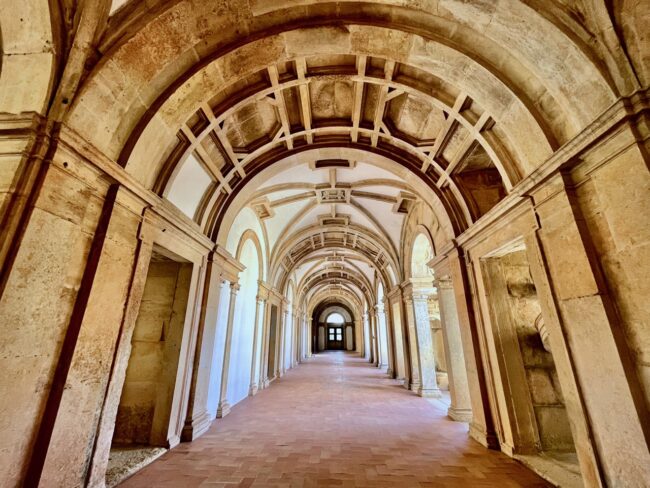
In honor of Prince Henry, we carefully navigated the nearby dizzying circular staircase.
From above we looked out at The Main Cloister, considered “a masterpiece of the European Renaissance.” It was finished in 1562.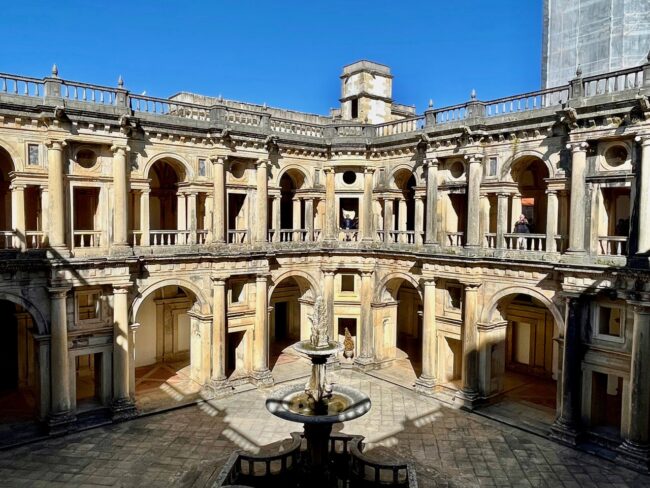
By now we were very excited, because we were nearing the “most famous and fantastical feature of the monastery,” the Janela Manuelina (Manueline Window). We had read that this architectural wonder is considered a “celebration of the Age of Discoveries.” When we reached the viewing area, alas, we found out it was undergoing “intervention and restoration” for the next year or so. Ah, the perils of traveling to ancient places.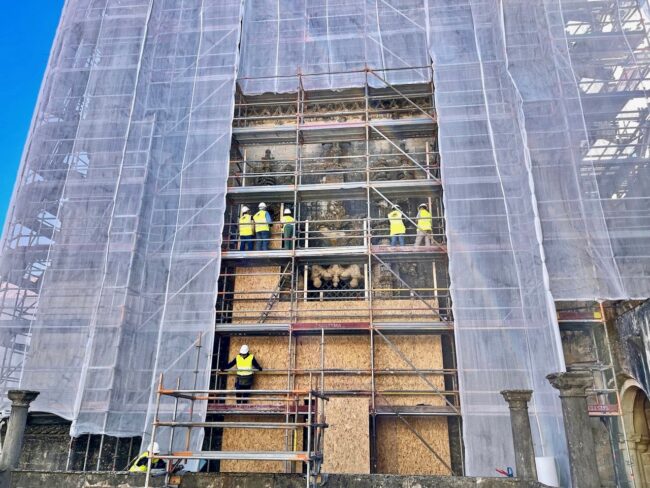
Not done with our quest, and much less exciting than the “fantastical” window we missed, we did stop by The Refectory after a walk on some more azuelo-lined steps.
Another cloister (and corridor) …
… and we were inside the Kitchen and the Oven Room.
I forget the name of this area (think it might be The Cistern), but if you feel like it’s a little bit of a tight space, you might call it the Claustro da Phobia.
The Claustro da Hospedaria was where guests and pilgrims of St. James were housed. If you were considered someone of higher social status, you got to stay on the upper floor. Others of lesser stature would stay on the lower level near the horse stable. “Let them eat hay!”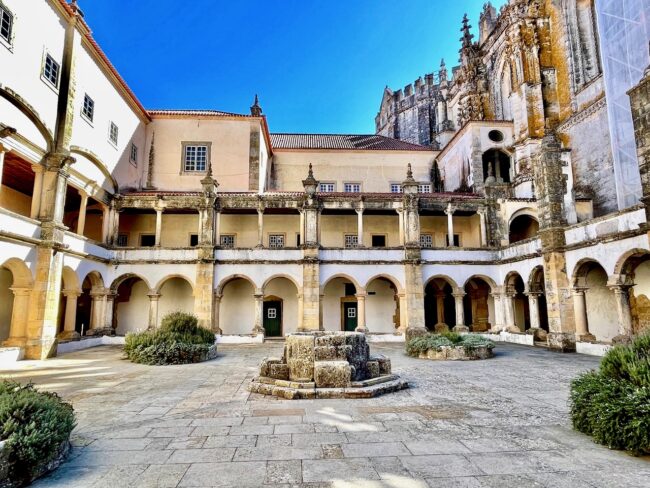
Before heading out we checked out some headstones. The headstone on the right shows a plowman goading a team of oxen, which meant the yoke was on them. The plowman bore a strange resemblance to Mr. Magoo.
On our way back to Tomar we scoped out more views and caught a glimpse of what looked like a small chapel.
After about a 2-minute walk we arrived at Mata Nacional dos Sete Montes (National Forest of the Seven Hills), a 96-acre national woodland. This was an area where the Order of the Christ grew crops. The bronze statue out front is of Henry, the Navigator.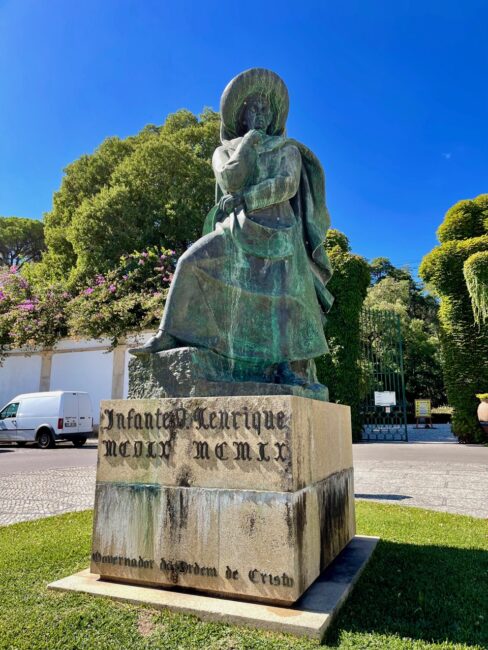
We spent about 30 minutes meandering part of the park grounds.
It also gave Tracy a chance to get her requisite flower photo. Unbeknownst to us, at the same time Tracy was taking these photos, Kim took his first (and only) tumble of the trip. Fortunately, no ambulance was needed to be called.
It made for a nice interlude.
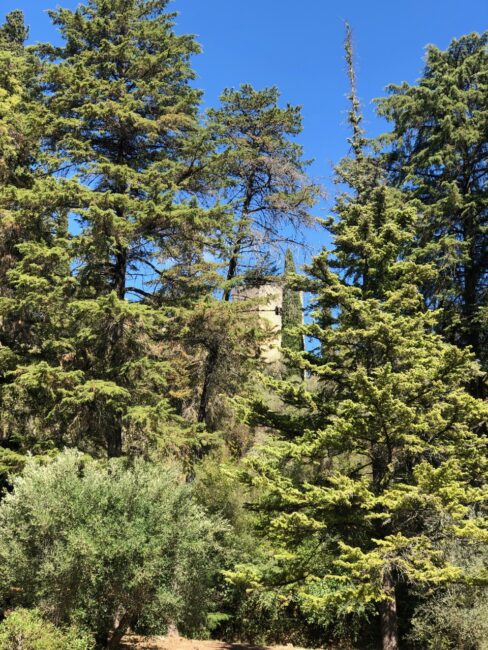 However the heat had taken its toll and we needed some rejuvenation, so we headed back across the “Bridge of Three Names” to find a place for lunch. As we crossed it, there stood a wooden water wheel under those weeping willows near one of the entrances to the island of Mouchão Park.
However the heat had taken its toll and we needed some rejuvenation, so we headed back across the “Bridge of Three Names” to find a place for lunch. As we crossed it, there stood a wooden water wheel under those weeping willows near one of the entrances to the island of Mouchão Park.
I thought about shooting some hoops in the park, but realized that would be difficult without a basketball. Back across the bridge we scouted out a place for a restaurant.
We found a nice spot for lunch at Tasquinha da Mitas.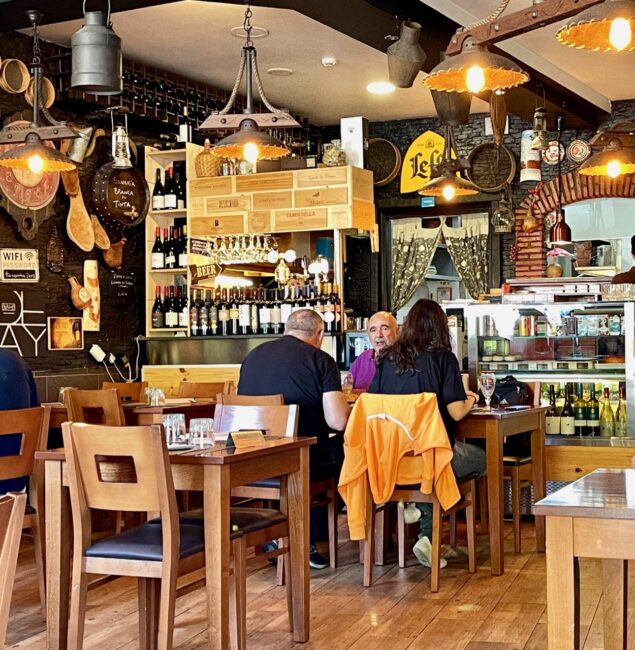
Walking through the charming streets of Tomar afterward, the ever present Convento de Cristo loomed large over town.
Our next stop held no interest for Kim and Mary, but I thought it could be a “match” made in heaven for Tracy and me. The Museu dos Fósforos
(Matchbox Museum) located in the Convento de São Francisco has a collection of around 80,000 matchbooks (about 43,000 are on display, and no, we didn’t see them all). I don’t think any similar type museum could hold a candle to that.
It seems back in 1953 collector Aquiles da Mota Lima took a ship to London to witness the coronation of Queen Elizabeth II. On board, he met a woman who asked if he could pick up some matchbox souvenirs of the event for her, along with some from other countries he visited. An obsession was born. (For some unknown reason, Tracy and I actually have the matchbook on the left.) That wasn’t the only royal event matchbox on display. I wondered if he played matchmaker for Andrew and Fergie.
By the time he returned to Portugal, Mota Lima had dozens upon dozens of matchbooks, and by the time he was done, nobody could match his collection.
There are matches from nearly 130 countries in the collection that was donated by Mota Lima in 1980.
The matchbook collection is segregated by three different time periods. I dare say this may be the only museum in the world that contains a picture of Bin Laden on a matchbox.
I, of course, found this museum much more interesting than Tracy, but we were both happy to be inside on another very hot day. I must admit, with a collection like this, I’m surprised Mota Lima didn’t strike it rich. I also wondered if the woman he met on the ship became an old flame.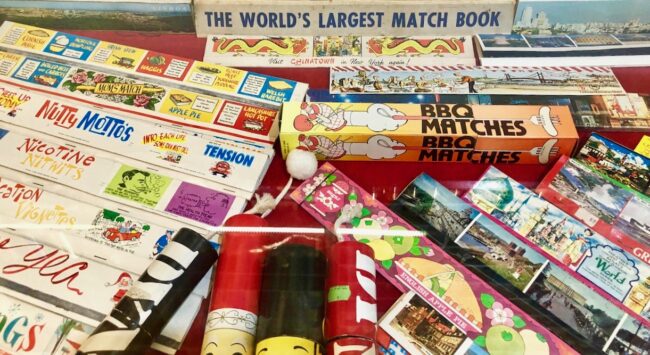
Although Glenn Miller trumpeted the virtues of this museum, Tracy said she’d like to go, and even though I wanted to see more, I was no match for her.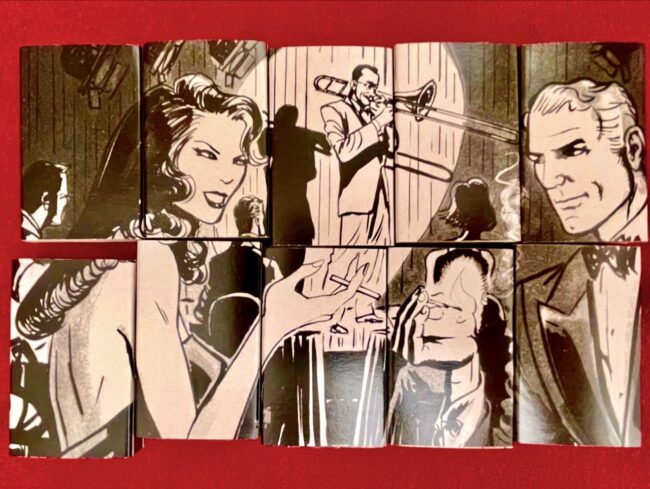
As we returned to town, I decided to put the “Tom” in Tomar.
Manuel Mendes Godinho played a big part in the economic development of Tomar in the early 20th century, and was rewarded with this bust.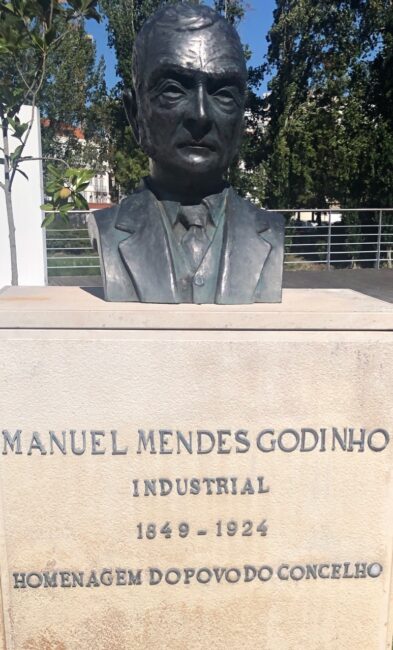
On our little afternoon stroll, I came upon some street art that I wanted to take a closer look at. Getting closer, I saw the words in the upper right hand corner that read “Perugo de Morte.” Not wanting to tempt the shocking “Danger of Death,” we quickly moved on.
We crossed a different bridge on the way back that offered a glimpse back on what we now called our “Home Bridge.” We figured why not give it a fourth name.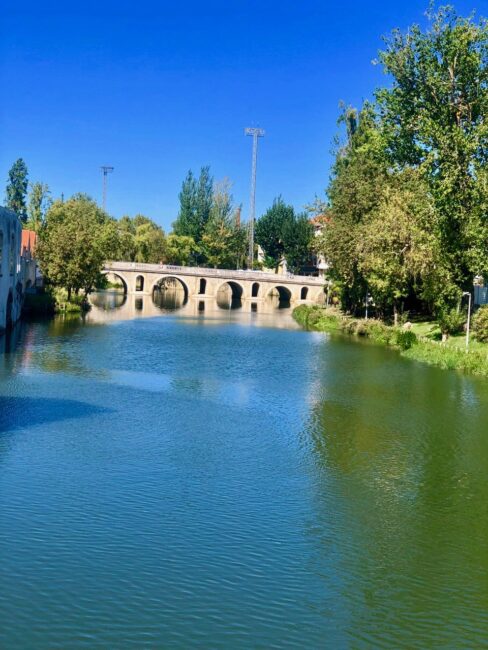
At this point it was a little after 3:30 p.m. and Kim and Mary, and now Tracy, decided it was time to relax. I also attempted to lay down for a bit, but after about 30 minutes, that was enough relaxing. In the room there was a little pamphlet about Tomar’s Heritage Trail. I decided to at least check out Igreja de Santa Maria do Olival. Along the way I stopped into the cemetery located along the route.
I never got the cemetery name, but I had to scurry over to the church in case it closed at 5 p.m. Igreja de Santa Maria do Olival was the “Church Mother of Mariners” (they never won a World Series in the 16th century either) during the Age of Discoveries in the 1500s. It has a three-story bell tower standing adjacent to it.
It is better known for its association with the omnipresent Knights Templar. The first Grand Master of the Templars and founder of Tomar, Gualdim Pais, is buried here, as are many other Templars.
The church is sometimes referred to as the “Pantheon of the Templar Masters.”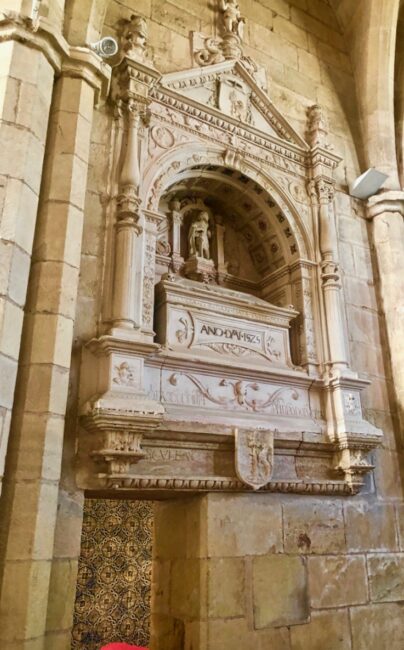
Are those hamburger buns? “Give us this day, our daily bread,” indeed.
Once again you can’t escape the beautiful tile work in Portugal.
Something else I couldn’t escape was getting back in time for wine on the rooftop before dinner. The construction work next door didn’t help the ambiance unfortunately. We each had a glass of wine, but once again the wind was whipping, plus it was time for dinner.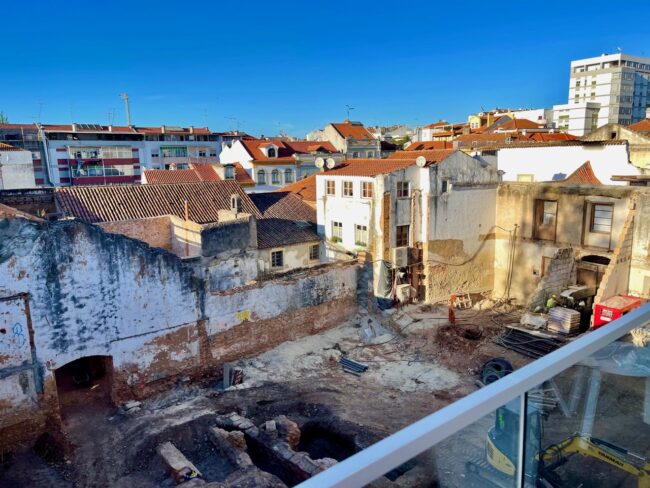
Sabores ao Rubro (Rua dos Moinhos 76 A) is the #1 Tomar rated restaurant on TripAdvisor, so I thought we’d give it a shot (reservations highly recommended). It deserves its rating. Shortly after this photo was taken, not an empty seat remained.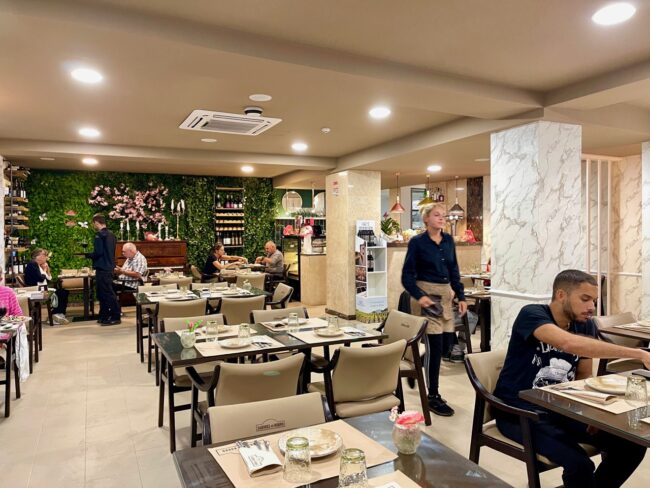
After ordering, some “equipment” was put on the table. I asked our real dental hygienist (and who is plays our physician on vacation) Mary, “Is someone having a tooth pulled before dinner?” 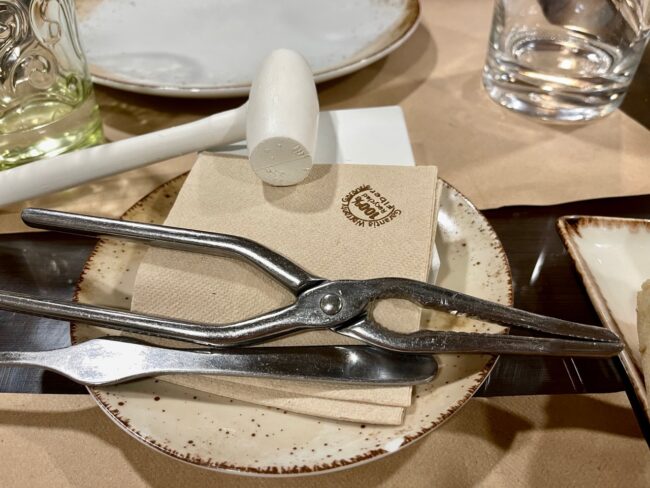
She just laughed and told us they were utensils for her to be able to enjoy her Seafood Rice.
Kim’s Shrimp Skewers on a Stick, oh man, did those look good!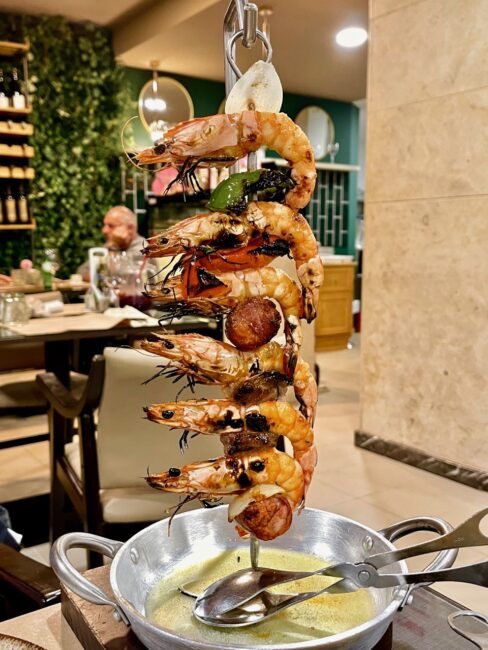
Although smitten with our server, after learning she was the owner’s daughter (this is a family run establishment) and the fact she was about 50 years younger than me, I was my usual gentlemanly self, especially since her dad was serving us the vinho.
By the way, my pepper steak smothered in a delectable sauce turned out tender and fantastic. Once again, one of the best steaks I have enjoyed. From what I perceived before our trip, I thought it would be difficult to find good meat dishes. How wrong I was! The beef dishes I enjoyed throughout Portugal were all top notch. 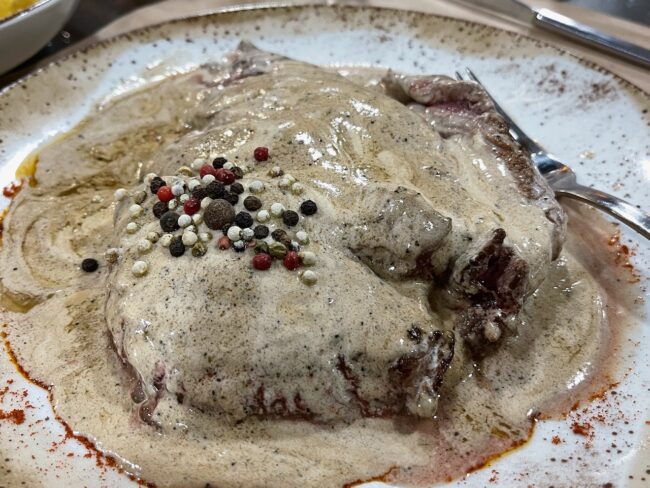
Not content with a steak the size of Wyoming, I also finished with a scrumptious cheesecake with fresh berries.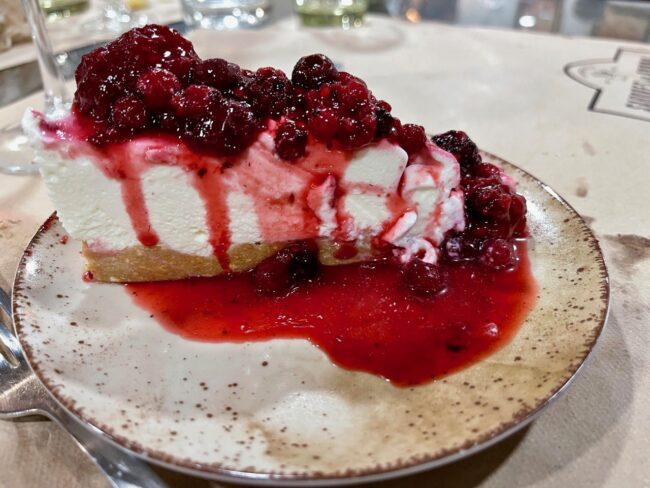
As we were dining, the family affair continued, a woman, who we believed was the cook sat down and started tickling the keys on the piano. After a very nice rendition of John Lennon’s Imagine, she continued with Bohemian Rhapsody. Mamma Mia, Mamma Mia, Figaro, she was really good! If only Freddie could have been here. 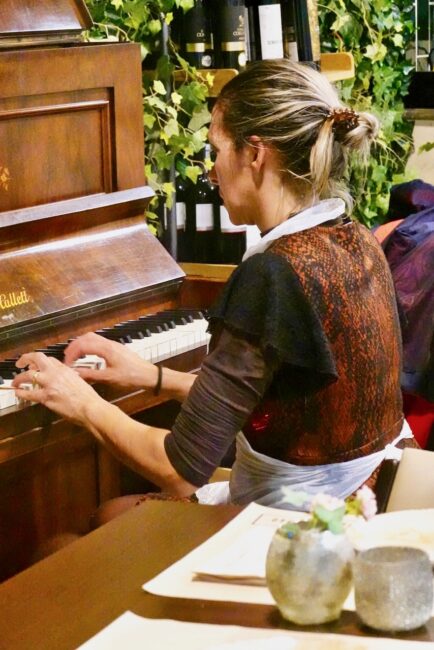
All our food, including entertainment, dessert and wine cost a grand total of €60 per couple. Portugal was not only turning out to have some of the best food we have eaten on our many trips, but also the best prices.
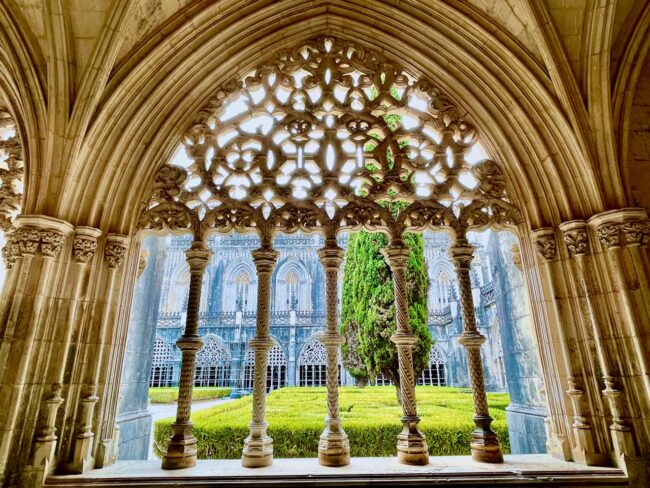 That would be it for Tomar, as the next day we’d head to college, well at least the college town of Coimbra. It’s never a straight shot anywhere for us … along the way we’d stop to explore an incredible 17th-century aqueduct that features 180 arches, then complete our World Heritage Trifecta at the huge Mosteiro de Santa Maria da Vitória and visit a castle that once housed King Dinis in the 14th century.
That would be it for Tomar, as the next day we’d head to college, well at least the college town of Coimbra. It’s never a straight shot anywhere for us … along the way we’d stop to explore an incredible 17th-century aqueduct that features 180 arches, then complete our World Heritage Trifecta at the huge Mosteiro de Santa Maria da Vitória and visit a castle that once housed King Dinis in the 14th century.
Arriving in Coimbra, my driving and our navigation “skills” were put to an ultimate test in our quest to find our elusively-located hotel. Did we eventually reach our accommodations? Stay tuned.
Next – Chapter Twelve: Tomar To Coimbra
Day Twelve: Arch Supports, Skipping “Our Lady,” Massive Monastery, In Search Of Henry, Sky Ceiling, Stadium Parking, Fit For A King, Trash Talking & Eating, Rental Car Peril, A Quirky Fun Hotel, Cape Town and Singing The Night Away

